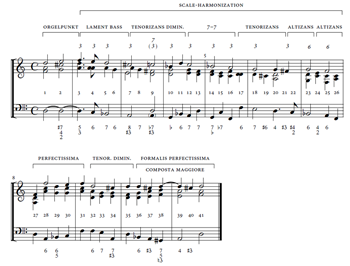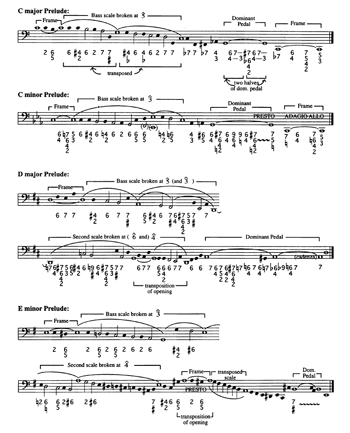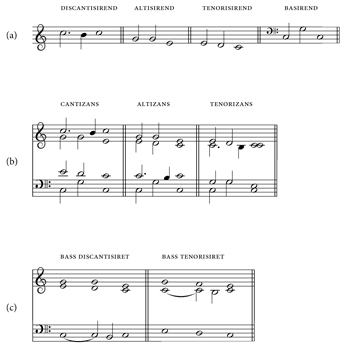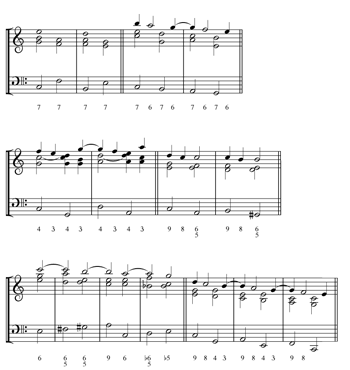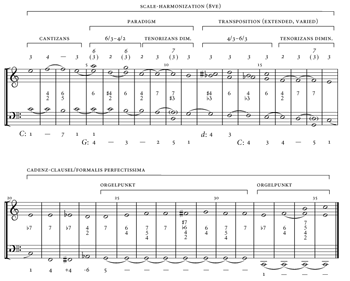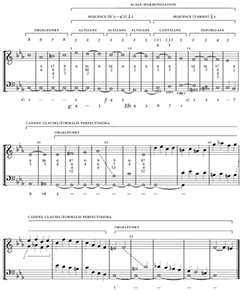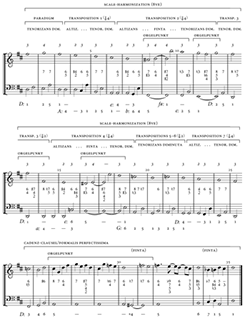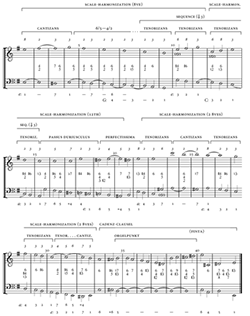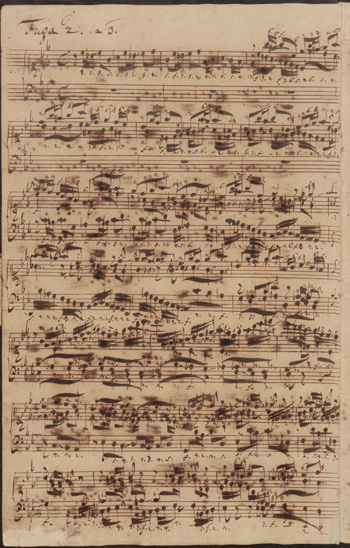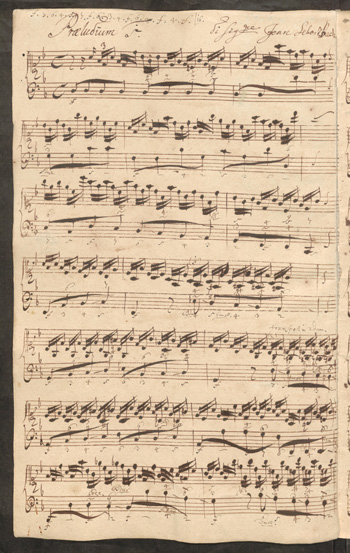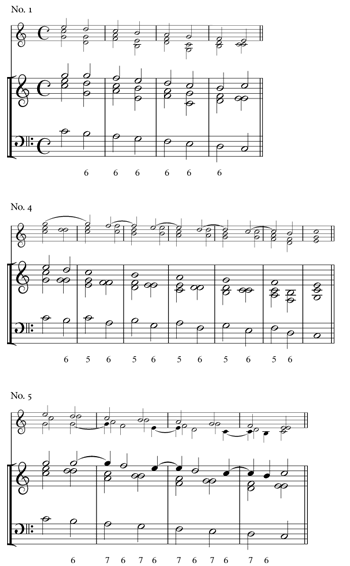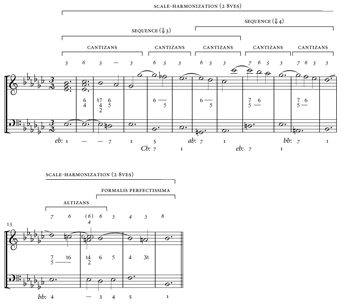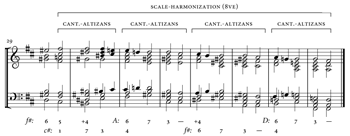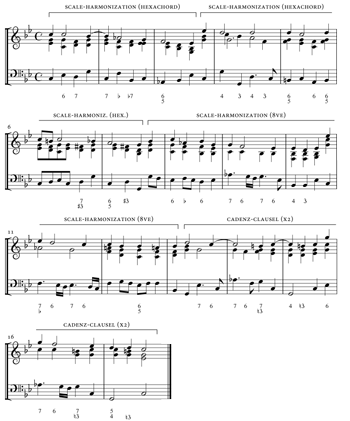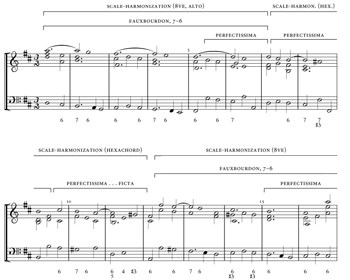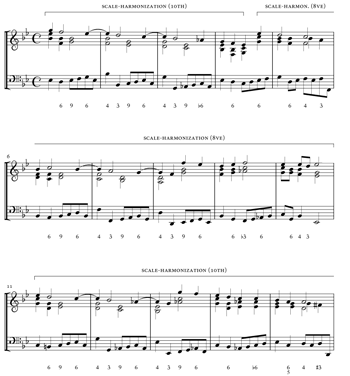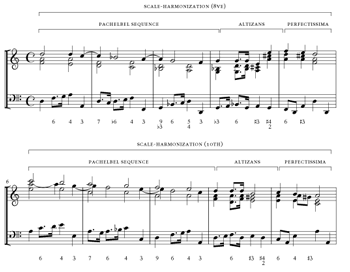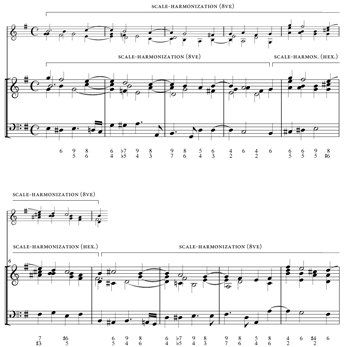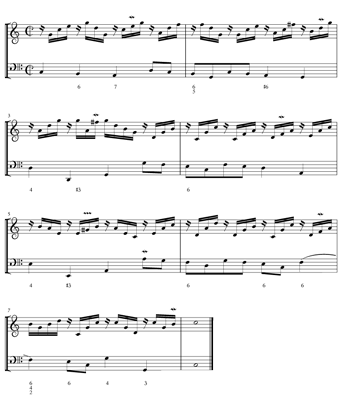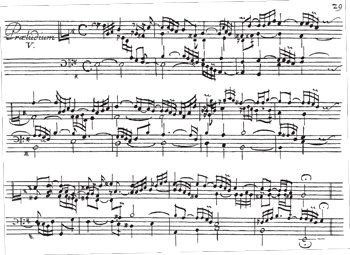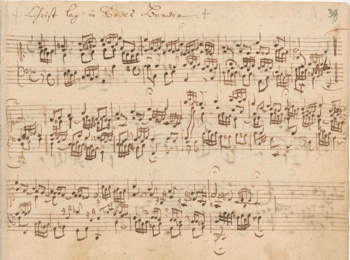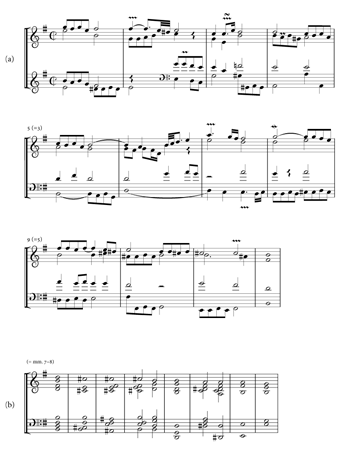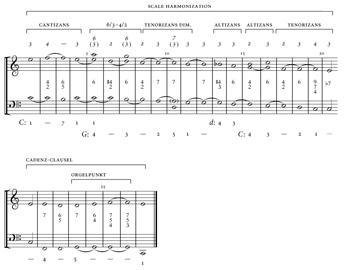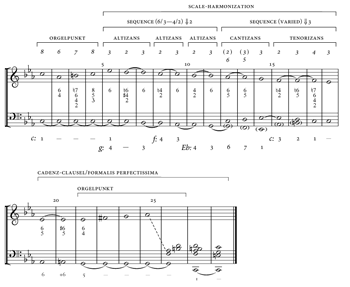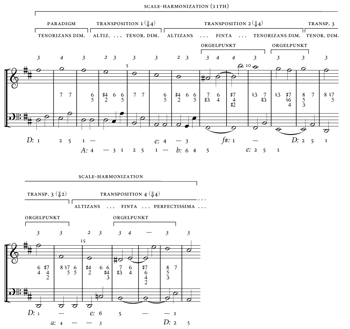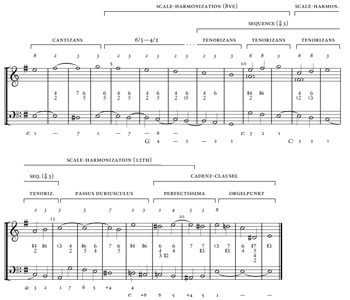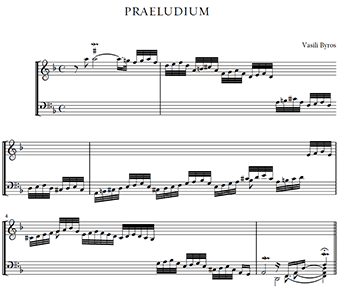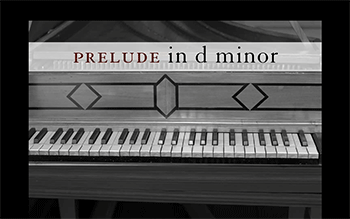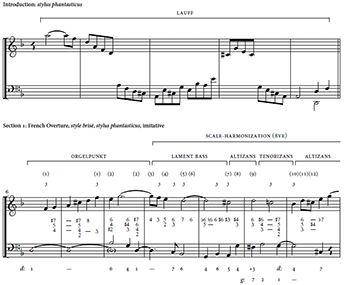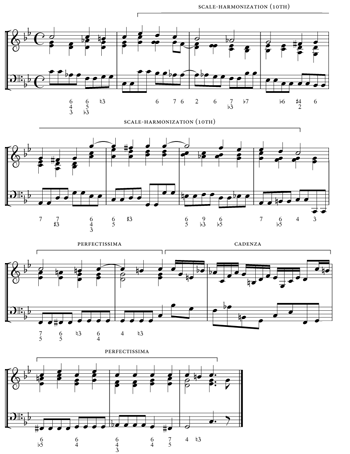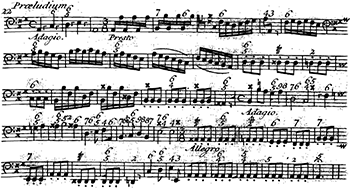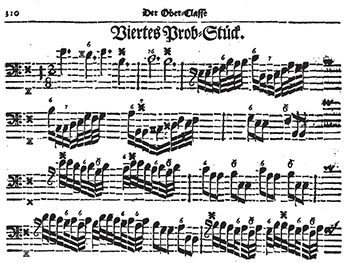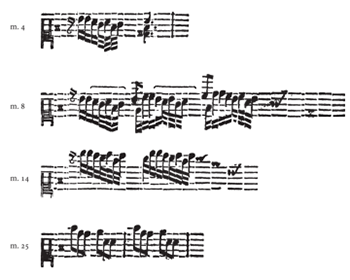Prelude on a Partimento: Invention in the Compositional Pedagogy of the German States in the Time of J. S. Bach *
Vasili Byros
KEYWORDS: composition, partimento, pedagogy, the Langloz manuscript (Mus. ms. Bach P 296), J. S. Bach, invention, locus exemplorum, exempla, The Well-Tempered Clavier
ABSTRACT: This article examines a hypothetical compositional and pedagogical use of the Langloz manuscript, a collection of German partimenti, during the time of J. S. Bach. The partimento is reconceptualized as a bridge to free composition, by aligning it with what Bach and his Thuringian and Hamburgian neighbors (including Werckmeister, Walther, Niedt, and Mattheson) called inventiones: materials for free composition that are subject to substantial development, involving processes of elaboration, variation, extension, and expansion. My argument is borne out by a historically informed practical demonstration: my own composition of a Prelude in D minor, which broadly derives from the partimento-prelude numbered 48 in the manuscript. The transformation of a simple thoroughbass into a fully worked-out composition pivots on two species of invention and their development, one structural, the other stylistic: 1) a genre-specific structuring principle that is coded into the partimento; for the prelude genre, this concerns long-range scale-harmonizations spanning 1–4 octaves; the principle recurs in several preludes of The Langloz Manuscript and of The Well-Tempered Clavier; and 2) the subject (thema) of a composition, which results from novel combinations of musical topics (Manieren), and the constructive imitation of other composers’ uses of styles and genres (locus exemplorum).
Copyright © 2015 Society for Music Theory
Most youthful composers let their fingers run riot up and down the keyboard, snatching handfuls of notes, assaulting the instrument in wild frenzy, in hope that something may result from it. Such people are merely Finger Composers—in his riper years Bach used to call them Harpsichord Knights—that is to say, their fingers tell them what to write instead of being instructed by the brain what to play. Bach abandoned that method of composition when he observed that brilliant flourishes lead nowhere. He realised that musical ideas need to be subordinated to a plan and that the young composer’s first need is a model to instruct his efforts.
—Johann Nikolaus Forkel, Johann Sebastian Bach (1802, 70–71)
1. Introduction: The Langloz manuscript in a New Light
[1.1] The state of Thuringia where Johann Sebastian Bach spent the first part of his life yielded the most renowned corpus of eighteenth-century partimenti of Germanophone provenance: a collection of preludes and fugues commonly known as the Langloz manuscript. Named after its scribe, August Wilhelm Langloz (1745–1811), a Thuringian who spent most of his life in Erfurt as a schoolteacher associated with St. Michael’s Church, the manuscript bears several intriguing connections to Bach and his musical circle. Langloz was likely a student of fellow Thuringian Johann Christian Kittel (1732–1809), also an Erfurt native who studied with Bach in Leipzig from 1748 until his teacher’s death in 1750 (Schulze 1980, 52). When Kittel later returned to Erfurt, following five years of employment as organist at St. Boniface Church in Langensalza from 1751–56, he had in his possession numerous manuscripts from Bach’s Nachlass. The Langloz manuscript, Mus. ms. Bach P 296, which is now housed in the Staatsbibliothek Berlin, is a copy of an earlier document that was presumably among the items from Bach’s Nachlass in Kittel’s possession. This copy is dated 1763, when Langloz would have been a student of Kittel and a member of what Hans-Joachim Schulze (1980, 52) has identified as the “Kittel circle”—a large group of students to whom Kittel exposed much of Bach’s keyboard music. Langloz’s copy even bears an explicit attribution to Bach on its title page, “39. Praeludia et Fugen | Del Signor | Johann Sebastian | Bach,” which led Wolfgang Schmieder (1990) to list P 296 as the twenty-second item in the preface to his catalogue of Bach’s works, while noting a few thematic connections to The Art of Fugue and The Well-Tempered Clavier.(1) Beyond the unique circumstances of its transmission, the contents of the manuscript intersect a keyboard genre intimately affiliated with the late master by mid-century—the prelude and fugue. P 296 contains two sets of compositions: one consists entirely of 38 fugues; the other comprises 22 works including three preludes and four independent fugues, and 15 prelude and fugue pairs, as in The Well-Tempered Clavier.(2)
[1.2] Most of the actual contents of the Langloz manuscript, however, were spuriously attributed to Bach’s pen. Having surveyed the available facts and evidence, William Renwick suggests the manuscript is “possibly a hybrid of compilation and composition by Bach,” in which case any Bach composition would be from 1707–1717 or earlier (Renwick 2001, 27). But one of the fugues (No. 22) was identified as a likely composition of Friedrich Erhardt Niedt, author of the reputable Musical Guide (1700–1721), because the same fugue appears at the end of its Part I.(3) This too points to a Bach connection, as Niedt studied with Bach’s eldest cousin, Johann Nicolaus Bach, at the University of Jena. From this and from the apparent stylistic similarities between the contents of the manuscript and the music of J. C. F. Fischer, Georg Philipp Telemann, and especially Johann Kuhnau and Johann Pachelbel, Renwick ultimately concludes: “Until further evidence comes to light, we can only hypothesize that the origins of the work are Thuringian, in the period 1700–20, that the contents may stem directly or indirectly from J. F. [sic] Niedt, J. N. Bach, J. S. Bach, or another contemporary composer altogether, and that the transmission as well as the attribution to Bach most likely involved Kittel” (2001, 28).(4)
[1.3] But whatever the truth may be, a more compelling question is not whether Bach composed the preludes and fugues of the Langloz manuscript, but rather how he may have used them, pedagogically and even compositionally. The allure of the manuscript is that it “may in some way represent Bach’s method of improvisation and composition” (Renwick 2001, 9). Bach’s esteemed biographer, Johann Philipp Spitta, voiced a similar opinion at the end of the nineteenth century: “There can be scarcely any doubt that [P 296] served as the continuation of [Bach’s] thoroughbass instructions” (Spitta [1883–85] 1951, vol. 3, 120)—a continuation, that is, of Bach’s Vorschriften und Grundsätze zum vierstimmigen spielen des General-Bass (1738), which is based on Part I of Niedt’s Musical Guide.(5)
[1.4] My ambition in this essay is to examine how that continuation may have involved the Langloz manuscript as a bridge to free composition, in light of Bach’s qualification, echoing Niedt, of the “thorough-bass [as] the most perfect foundation of music” (Bach [1738] 1994, 10).(6) What follows necessarily remains a hypothesis: I have no direct evidence indicating Bach or any of his contemporaries used the contents of the Langloz manuscript in the ways explored below. But the hypothesis is borne out by a historically situated practical demonstration: my own historically informed composition of a Prelude in D minor (Example 30 below), which derives—in an extended sense of the term—from a specific partimento prelude in P 296, and its contextualization within the larger pedagogical and compositional thought of the German states in Bach’s time.
Example 1. Langloz manuscript, Prelude No. 48 in D minor (c. 1700–1720)
(click to enlarge)
[1.5] The Langloz partimento on which this prelude is based, transcribed in Example 1, weighs in at only 11 measures in length, and consists of a figured bass with mostly quarter notes and no discrete thematic profile or recognizable motivic content in its bass line. The development of this partimento into a substantial composition serves as a practical demonstration of my basic line of argument—namely, that the contents of the Langloz manuscript may be treated as inventiones, a concept intimately familiar to Bach and his Thuringian and Hamburgian neighbors, including Andreas Werckmeister, Johann Gottfried Walther, and Johann Mattheson, in addition to Niedt. This broader theme in Germanophone compositional pedagogy of the late Baroque suggests that, in certain pedagogical and compositional circumstances, the Langloz manuscript’s preludes and fugues may have functioned as storehouses of “patterns of invention” in Laurence Dreyfus’ (1996) terms: genre-specific materials for free composition that are subject to substantial development, involving processes of elaboration, variation, extension, and expansion.
[1.6] The motivation for (re)conceptualizing the function of P 296 in this way comes from Bach himself, who advanced both the Two-Part Inventions and Three-Part Sinfonias as well as The Well-Tempered Clavier as compositional models intended to develop the facility of student composers. Along with the keyboard suites and studies in thoroughbass, these works formed part of Bach’s teaching program (Ledbetter 2002, 126–31).(7) In presenting his own works as guides for teaching composition and fostering creativity, Bach adopted an example-based method of teaching that his Hamburgian contemporary Mattheson described, via analogy with Classical rhetoric, in terms of locus exemplorum (1739, §81, 131; Eng. trans. [1739] 1958, 82): the constructive imitation, assimilation, and development of other composers’ materials.(8) What we know of Bach’s teaching strongly resonates with the proverbial message that Mattheson placed on the title page of his own Exemplarische Organisten-Probe (1719): “The journey is long by rules, but short and efficient by examples” (“Longum iter est per praecepta, breve et efficax per exempla”–Seneca). The results of this precept are at times patently seen in the work of Bach’s students. A telling example comes from his prize pupil, Johann Ludwig Krebs (1713–80), whose G-minor Overture in the French Style bears potent allusions to Bach’s own work by the same name (BWV 831, in B minor), as well as to Handel’s Overture from his keyboard suite, also in G minor (HWV 432). And Bach is known to have exercised the exempla principle as an integral aspect of composition not only in his role as a pedagogue but also as a composer himself (Jones 2006; 2008; 2013).(9) For example, his C-minor Passacaglia, BWV 582 (c. 1706–13), reads almost as a discursive paraphrase of Buxtehude’s Passacaglia in D minor, BuxWV 161 (before 1707) as well as his G-minor Prelude, BuxWV 149 (before 1690).(10) The passage from Johann Nikolaus Forkel’s biography (1802) cited in the epigraph above goes on to list Bach’s numerous models, including “Vivaldi[,]
[1.7] These broader connections indicate that Bach and his Germanophone contemporaries may have viewed the Langloz manuscript in a similar light—as a storehouse of exempla, and in various capacities. Indeed the partimento which served as the foundation of my prelude is representative of structural principles that recur across several preludes in the Langloz manuscript, which exhibit deep connections to Bach’s music, particularly a number of preludes from The Well-Tempered Clavier. And Bach is otherwise known to have “adapt[ed] material to [students’] needs and abilities” (Ledbetter 2002, 130), so that the Langloz manuscript would not mean the same thing to all pupils. Together these circumstances invite us to view the manuscript within a larger pedagogical corpus and tradition, one that is aligned with “invention” as a strain of compositional thought in the late German Baroque. To do so will bear implications not only for understanding compositional processes in the first half of the eighteenth century, for the pedagogy of music theory today, and for discovering the roles of partimenti in free composition, but also for early music practitioners with wider aspirations for historically informed composition, specifically what the early music scholar-performer Bruce Haynes called “period composing” (2007, 203–14).(12)
[1.8] In what follows, I gradually proceed through the concepts, strategies, and historical sources that allowed for the transformation of Langloz 48, a simple and unadorned partimento (Example 1), into a fully worked-out Prelude in D minor (Example 30). Broadly, this involves a consideration of two species of “invention” and their combined development, the one structural, the other stylistic. The first concerns a genre-specific structuring principle that is coded into the partimento; for the prelude genre, this involves long-range scale-harmonizations spanning 1–4 octaves; the principle recurs in several preludes of the Langloz manuscript and The Well-Tempered Clavier. The second, stylistic species of invention treats the subject (thema) of a composition, which results from novel combinations of musical topics (Manieren and figurae), and the constructive imitation of other composers’ uses of styles and genres (locus exemplorum).
2. Invention as Structuring Principle (Species 1)
[2.1] Bach’s two sets of keyboard works, popularly known today as the Two-Part Inventions and Three-Part Sinfonias (BWV 772–801), were originally titled Praeambula and Fantasias in the Clavier-Büchlein for his son Wilhelm Friedemann. When later inscribing a title page (1723) for both sets, Bach (the father) characterized all thirty works as inventiones—apparently, as Dreyfus has also suggested, on account of their compositional-pedagogical value (1996, 1; see also Ledbetter 2002, 52):
Upright Instruction
wherein the lovers of the clavier, and especially those desirous of learning, are shown a clear way not only (1) to learn to play clearly in two voices but also, after further progress, (2) to deal correctly with three obbligato parts; furthermore, at the same time not only to have good inventiones but to develop the same well. . . and to acquire a strong foretaste of composition.
(David and Mendel 1998, 97–98)
In his seminal study on the concept of invention in Bach’s music, Dreyfus highlights a subtlety in this title page which indicates that invention is not simply a “well-crafted object,” but also a “mechanism for discovering good ideas,” one “that triggers further elaborative thought from which a whole piece of music is shaped” (1996, 2). Bach’s description of the inventiones as both models and instructions for their development—“to develop the same well”—makes clear that invention involves both a thing and a process, whose discovery, replication, and development instill “a strong foretaste of composition.”
Example 2. The Langloz manuscript, Prelude No. 48: chordal realization and scale-harmonization principle
(click to enlarge and listen)
[2.2] As an encrypted composition or midpoint between compositional formulas and musical work, the partimento is ideally suited to enact this process of “discovering” an invention, in the sense of an idea—as Dreyfus words it in a compelling and apt phrase—that “unlocks the door to a complete musical work” (1996, 2). And this discovery may occur even with the seemingly simplest of basses. By looking only at the surface of the prelude of Langloz 48 (Example 1), and especially at the notable absence of distinctive motivic material, the partimento appears to say very little about how it might represent the prelude genre. But the broader lesson to be learned from this and other preludes in P 296 concerns invention as a structuring principle that is common (though not exclusive) to the genre, as exemplified in the Langloz manuscript and The Well-Tempered Clavier. Example 2 presents a simple chordal realization which illustrates that nearly the entirety of the partimento is built on a scale-harmonization of an octave in the melody, to and from scale degree 3.(13) The melodic descent covers mm. 2–7, while mm. 9–10 elaborate scale degree 3 through a neighboring G, and mm. 1–2 ascend to the mediant from the tonic. The bass descends along with the melody in parallel 10ths for the entire scale, save for its endpoint at m. 7, which marks a modulation to the relative major. Here, the descending bass moves in parallel 6ths with the melody, rather than 3rds, on account of what Johann Gottfried Walther ([1708] 1955; 1732), Bach’s cousin and close friend, described as a clausula altizans, an “alto cadence” (with 4–3 or 5–3 in the bass), also known as a cadence detournée and clausula saltiva imperfectior (Walther 1732, 125 and 171). Framing the scale-harmonization on either side is an Orgelpunkt (pedal point) at the beginning—with do–re–me (or me–fa–me) in the melody—and an extended cadence at the end. Walther called this particular close a clausula formalis perfectissima, which is roughly equivalent to the modern-day perfect authentic cadence.
[2.3] Coded into the thoroughbass of this short partimento prelude is a structural framework that is nearly identical to four of the preludes from Book 1 of The Well- Tempered Clavier, which Joel Lester has identified as something of a “mini-series” within the larger collection (1998, 33): those in C major, C minor, D major, and E minor. Lester observed that the four preludes generally reflect a prescription for extemporizing or preludizing that is advanced in C. P. E. Bach’s Versuch über die wahre Art das Clavier zu spielen (1753–62):
[A] keyboardist. . . fashions his bass out of the ascending and descending scale of the prescribed key, with a variety of figured bass signatures; he may interpolate a few half steps [that is, chromaticism], arrange the scale in or out of its normal sequence, and perform the resultant progressions in broken or sustained style at a suitable pace. A tonic organ point is convenient for establishing the tonality at the beginning and end. The dominant organ point can also be introduced effectively before the close.
(Bach [1753–62] 1949, 431–32)
Example 3. Annotated Thoroughbass Renderings of J. S. Bach, Preludes in C major, C minor, D major, and E minor, Well-Tempered Clavier, Book I (from Lester 1998, 35)
(click to enlarge)
Example 3 reproduces Lester’s bass-line summaries for the mini-series. As shown, each prelude is substantially structured on one or more descending scales in the bass, which are flanked by a “lingering” on the tonic, as C. P. E. Bach described it (sich lange aufhalten) ([1753–62] 1949, 327). Lester refers to these lingerings as a “frame: a tonic-defining progression, either a literal ‘tonic organ point’ as C. P. E. suggests, or a closed, tonic-prolonging ‘imitated cadence’ (to paraphrase Rameau’s contemporaneous term for a cadential progression
Example 4. Andreas Werckmeister, Harmonologia Musica (1702, 48–49): clausulae
(click to enlarge)
[2.4] Germanophone music theory in the later Baroque had a rich typology of clausulae to describe these cadences. Among them are three cadence types in which the bass adopts voice-leading motion that is characteristic of upper parts: the clausula tenorizans (“tenor cadence,” 2–1), clausula altizans (“alto cadence,” 5–3 or 4–3), and clausula cantizans (“soprano cadence,” 7–1).(14) These categories appear not only in the writings of Bach’s cousin and friend Walther, but also in those of Andreas Werckmeister (1702), which were well-known to Johann Sebastian. The clausulae specified both a voice-leading motion particular to a part, and a type of cadence which assigns one of these motions to the bass.(15) Example 4a shows all four of the melodic clausulae in Werckmeister’s Harmonologia Musica (1702), followed by his different distributions of the three upper-voice types in the context of a bass cadence in Example 4b. Werckmeister then illustrates the ability of the bass part to “discantize” (Discantisiret) and “tenorize” (Tenorisiret)—a formulation also found in Walther (1732, 171)—as shown in Example 4c, which results in the clausulae cantizans and tenorizans, respectively.
[2.5] A brief anthology of numerous cadence types derived from German writings of the late Baroque is provided in the Appendix. In general, there is a hierarchy of clausula types that Walther makes explicit in his definition of the term as “a close [Schluß], or only a clause [nur ein Absatz]” (Walther 1732, 170; see also Deppert 1993). Not only is this hierarchy affected by the relocation of upper voices to the bass, thus rendering a cadence less “perfect” or conclusive, but the closure of the “bass-cadence” types (Basierende; Werckmeister 1702, 50) also varies by the type of clausula (discant, alto, or tenor) used in the upper voice (as in Example 4a), and by the length of the cadence. The D-minor Prelude of Langloz 48 actually closes with an extended variant of the clausula formalis perfectissima: the cadenza composta maggiore (Walther 1732, 124; examples are provided in the Appendix, 2). Niedt distinguished these from other less conclusive clausulae by designating them Cadenz-Clauseln (1710 [1989], 40–41, 126–27; Appendix, 5–6).(16) The lengthy dominant pedals that appear in the closing cadences of the preludes in The Well-Tempered Clavier are highly extended versions of this extendirte Cadenz (Walther 1732, 124). Their opening “frames,” on the other hand, rely on the less perfect clausulae: the C-major and E-minor preludes begin with the clausula cantizans (Examples 5 and 8 below), the D-major prelude with a clausula tenorizans diminuta, a tenor cadence with the diminution of a bass leap to the dominant between scale degrees 2 and 1 (Example 6 below). Whereas the opening clausulae in the preludes are Absätze, their final cadences are (more or less extended) Schlüße.
Example 5. C. P. E. Bach, Versuch (1753–63): thoroughbass patterns for the construction of a Bassthema with a “singing upper part” (author’s realization)
(click to enlarge)
[2.6] The D-minor Prelude of Langloz 48 thus shares an overall design or script that is common to the four preludes of the mini-series in The Well-Tempered Clavier, which may be summarized as: 1. clausula/Orgelpunkt (Absatz) 2. bass octave-harmonization(s) 3. clausula perfectissima (Schluß) 4. Orgelpunkt. This design reveals only one part of the story, however: prior to the discussion of improvisation, C. P. E. Bach’s Versuch (1753–63) features a short section on the construction and accompaniment of a Bassthema (literally a “bass theme,” such as an ostinato), in which he prescribes the following: “the bass should be accompanied [i.e., harmonized] by chords that express numerous, effective suspensions which allow for the construction of a singing principal part” (eine sangbare Hauptstimme; 427) or “singing upper part” (eine sangbare Oberstimme; 429). In light of the larger discussion, C. P. E. Bach’s examples indicate that by “singing” he means stepwise motion in the melody: “Especially recommended [accompaniments or harmonizations] are progressions which permit the use of many seventh, five-four, six-five, and ninth chords” (Bach [1753–62] 1949, 427). All of Bach’s accompanying examples that use these figures will produce continuous descending stepwise lines (with the exception of one ascending sequence), as shown in my realization in Example 5. These “singing upper part[s],” moreover, indicate not the actual melody, but something of a structural melody, or, to use C. P. E. Bach’s own term, a “skeleton” (das Gerippe; [1753–62] 1949, 441): he later indicates that the Bassthema and its particular harmonization “provide opportunities for the elaboration [Ausarbeitung] of the principal part” (428; my emphasis). Later still, Bach advises those “who lack
Example 6. J. S. Bach, Well-Tempered Clavier, Book I, Prelude in C major (1722): analytic reduction
(click to enlarge)
[2.7] Each prelude in The Well-Tempered Clavier’s mini-series also features such a “singing upper part” as a “skeleton”: an uninterrupted descending scale in its structural melody. In each case, the descent moves in parallel tenths with the bass, and to and from scale degree 3, precisely as in the D-minor Prelude of Langloz 48. Detailed analytic reductions for all four preludes are given in Examples 6–9. The reductions are modelled on an analytic practice observed in Bach’s own musical circle: an early manuscript copy of Book I of The Well-Tempered Clavier, housed in the Staatbibliotek Berlin (Mus. ms. Bach P 401; 1722–23), contains analytic annotations of the C-minor Fugue and the D-minor and B-minor Preludes. The annotations clarify the underlying figured-bass, analyze the tonality and modulations via scale-degree designations in the bass, and illustrate the counterpoint between the lowermost and upper voices (for the fugue). Examples 10 and 11 reproduce the first manuscript pages of the C-minor Fugue and the D-minor Prelude. Though the identity of its copyist, formerly referred to as Anonymous 5 (Schulenberg 2006), remained a mystery for some time, he was recently identified (Talle 2003, 155–72) as one of Bach’s pupils in Cöthen and later Leipzig: Bernhard Christian Kayser (1705–58), who later returned to Cöthen and served as organist and chamber musician. The reductions in Examples 6–9 similarly provide a figured-bass and scale-degree analysis of the bass line, with the addition of the “singing-upper part,” in order to demonstrate the outer-voice “skeleton” for each prelude. Though varied throughout the mini-series, and with increasing degrees of complexity as regards harmonization and use of thoroughbass patterns, overall tonal plan, transpositions of material, and so forth, the four preludes are substantively built on a common blueprint: one or more series of descending scales in parallel tenths in the outer voices.(18) In each case, the scale harmonization is flanked by a tonic “lingering,” whether an Orgelpunkt or some variety of imperfect clausula.
|
Example 7. J. S. Bach, Well-Tempered Clavier, Book I, Prelude in C minor (1722): analytic reduction (click to enlarge) |
Example 8. J. S. Bach, Well-Tempered Clavier, Book I, Prelude in D major (1722): analytic reduction (click to enlarge) |
Example 9. J. S. Bach, Well-Tempered Clavier, Book I, Prelude in E minor (1722): analytic reduction (click to enlarge) |
|
Example 10. J. S. Bach, Well-Tempered Clavier, Book I, Fugue in C minor, manuscript copy, SBB Bach Mus. ms. P 401 (1722): analytic annotations by Bach’s pupil, Bernhard Christian Kayser (click to enlarge) |
Example 11. J. S. Bach, Well-Tempered Clavier, Book I, Prelude in D minor, manuscript copy, SBB Bach Mus. ms. P 401 (1722): analytic annotations by Bach’s pupil, Bernhard Christian Kayser (click to enlarge) |
Example 12. J. S. Bach, Vorschriften, “Principles for Playing in Four Parts” (1738): “singing” upper parts
(click to enlarge and see the rest)
[2.8] Teaching this invention and its possible realizations are conceivably among the pedagogical implications of The Well-Tempered Clavier that Bach alluded to on its title page, when he offered the work “for the use and profit of the musical youth desirous of learning, as well as for the pastime of those already skilled in this study” (David and Mendel 1998, 97).(19) All four preludes expand on a broader principle that Bach introduces in his Vorschriften, under a section titled “Principles for Playing in Four Parts.” The section presents fourteen different (but related) thoroughbass sequences followed by a cadence, all of which but two (nos. 2 and 3) descend. Realizations for the twelve descending exercises (minus the closing cadence) are provided in Example 12. (All fourteen of the original exercises repeat their respective patterns in the keys of the dominant and submediant, followed by a da capo return to the tonic. For this reason only the C-major section is given in Example 12.) Nos. 13 and 14 present the ![]()
![]()
![]()
![]()
Example 13a. J. S. Bach, Well-Tempered Clavier, Book I, Prelude in E-flat minor (1722): analytic reduction
(click to enlarge)
Example 13b. J. S. Bach, Prelude in B minor, BWV 923 (1725), mm. 29–36: annotated
(click to enlarge)
Example 14. The Langloz manuscript, Prelude No. 44 in C minor: author’s basic chordal realization
(click to enlarge and listen)
[2.9] The parallel-tenths blueprint in the mini-series of The Well-Tempered Clavier and in Langloz 48 is but one realization of a broader invention or structuring principle that is characteristic of the prelude genre: long-range scale harmonizations. The scale(s) may vary in length from a hexachord to as many as four octaves, and appears principally in the melody. But the invention may involve a melody-bass pairing of scales (as in the mini-series), a melody and inner-voice pairing of scales, a trio of descending scales involving the outer voices and an inner voice, or simply a bass scale. The E-flat minor Prelude from Book I of The Well-Tempered Clavier, for example, descends two octaves in its structural melody, to and from scale degree 5, but over a disjunct (and variously sequential) bass, from mm. 1–16. Example 13a provides a thoroughbass reduction that is adapted from analytic annotations in a later manuscript copy of The Well-Tempered Clavier, SBB Mus. ms. Bach P 1075. The copy and analytic annotations are those of another Bach student, Christian Friedrich Penzel (1737–1801), who became prefect at the Thomasschule after Bach’s death (Boyd 1993, 60).(21) The realization of the upper part, which outlines the structural melody of Bach’s prelude, is my own. A similar structure appears in the roughly contemporary Prelude in B minor, BWV 923 (1725), shown in Example 13b.(22) Both passages complete a scale to and from scale degree 5 (of the global tonic) in the melody, and make use of a descending-third sequence.
[2.10] The same idea underlies several preludes in the Langloz manuscript, which feature primarily disjunct basses, but are organized by long-range scale harmonizations in the upper parts, which at times are directly specified or implied in their figures. These include, among others, the preludes numbered 44 (C minor), 47 (D major), 49 (D minor), 53 (E-flat major), and 54 (E minor), realized in Examples 14–18. Prelude No. 47 in D major (Example 15), for instance, descends stepwise for three whole octaves plus a fifth in the melody, a highly long-range scale harmonization achieved by combining 7–6 suspensions, simple fauxbourdon, descending-fifth sequences with seventh chords, and 4–3 suspensions. No. 54 in E minor (Example 18) is something of a tour-de-force illustration of the invention, with a proliferation of the suspension types C. P. E. Bach suggests in the Versuch. This prelude is built on no fewer than four uninterrupted octave descents (plus a minor third) in its melody, from beginning to end. Similar to the Vorschriften exercises, an inner voice can be relocated to the uppermost part, allowing for variation of the structural melody, a feature that is common to several preludes of P 296. For No. 54, doing so results in a “singing upper part” and overall structure that is similar to the E-flat minor Prelude of The Well-Tempered Clavier’s first book (Example 13a). An alternate realization for mm. 1–7 of the partimento is given in the ossia staff of Example 18. Much like Bach’s E-flat minor Prelude, it features an octave descent to and from scale degree 5 that culminates with a modulation and clausula formalis perfectissima in the key of the dominant (compare Examples 13 and 18, ossia staff). And, as with all the preludes in the mini-series, the descending scale is bordered by an opening tonic lingering (m. 1)—a clausula cantizans, as in the Well-Tempered E-minor and C-major Preludes—and a clausula perfectissima at its end (mm. 5–7).
|
Example 15. The Langloz manuscript, Prelude No. 47 in D major: author’s basic chordal realization (click to enlarge, see the rest, and listen) Example 17. The Langloz manuscript, Prelude No. 53 in E-flat major: author’s basic chordal realization (click to enlarge, see the rest, and listen) |
Example 16. The Langloz manuscript, Prelude No. 49 in D minor: author’s basic chordal realization (click to enlarge, see the rest, and listen) Example 18. The Langloz manuscript, Prelude No. 54 in E minor: author’s basic chordal realization (click to enlarge, see the rest, and listen) |
[2.11] The preludes of the Langloz manuscript collectively provide a means of discovering an invention as a structuring principle that is characteristic of the prelude genre, specifically through the pragmatic act of realizing a thoroughbass. The invention does not simply involve the use or recognition of a structural object or pattern, such as a series of parallel tenths. Nor, as Dreyfus maintained, can it be reduced to a single abstraction that recurs across works of different styles—“a fruitless effort, since the type of invention will depend on many factors such as genre and style” (1996, 14). Rather, invention indicates a genre-specific “mechanism,” which for the prelude involves different ways of “construct[ing],” to use C. P. E. Bach’s term, a long-range scale or “singing principal part.” Because an invention is a mechanism and not a single object or pattern, it invites exploration and discovery: examining and working through which thoroughbass formulas in what combination will produce a long-range scalar descent. The principle is general enough to allow for numerous (and novel) realizations. And it is on account of this generality that an invention “triggers further elaborative thought from which a whole piece of music is shaped” (Dreyfus 1996, 2).
[2.12] Many different realizations of the structuring principle, with different levels of complexity and great variety, can be seen across partimento preludes within the Langloz manuscript and across different preludes within The Well-Tempered Clavier. For instance, the C-major Prelude of Book I (Example 6) realizes its scale harmonization via a single transposition of a paradigm, which consists of a ![]()
![]()
![]()
![]()
![]()
![]()
[2.13] The same variety and graded complexity is also seen across the different pedagogical works available to Bach for his own teaching: the Vorschriften, the Langloz manuscript, and The Well-Tempered Clavier. The prelude from Langloz 47 in D major (Example 15), for instance, uses stock thoroughbass formulas outright, with little difference compared to the same patterns in the Vorschriften. Aside from the change to a sarabande meter, a few neighbor tones in the bass, and the addition of a clausula perfectissima, mm. 1–7 of the prelude are essentially a transposition of the fourth four-part exercise in the Vorschriften, which pairs a descending hexachord and octave (soprano and alto) with another descending octave in the bass (compare Example 15 and Example 12, no. 5). The remainder of the prelude features a large-scale transposition of mm. 1–12 at mm. 12–23, and then a more substantial variation of the opening that introduces a number of cadences, including evaded cadences, which Walther variously described as cadences évitées or feintes, and cadenze finte or sfuggite (Walther 1732, 125). The same applies for Langloz 54: despite the intricacy of its primary building block, with its many suspension figures, the length of the prelude results from macro-transpositions of material—sequencing large blocks of music. The D-major Prelude of Book I, however, displays a more novel means of realizing the scale-harmonization invention. Whereas the Langloz D-major (as well as the E-minor) Prelude generates its many scales via macro-level transpositions that feature minimal variation, extension, and expansion of its paradigm, the Well-Tempered D-major employs the principle of ars combinatoria (Ratner 1970; 1980), in order to create an incremental build-up to its scales via transposition, extension, and expansion of smaller units. In its first downward transposition to A major, a clausula altizans is added to the tenorizans diminuta of the paradigm (Example 8). In the second transposition, to E minor, the clausula altizans addition is retained, while scale degree 2 of the tenorizans diminuta,
[2.14] In sum, the four-part exercises of the Vorschriften generate material through pure large-scale transposition with no variation (within each exercise). The Langloz preludes produce their content by sequencing large-scale musical units with some degree of variation. But the mini-series of The Well-Tempered Clavier constructs its long-range scales largely through the varied sequencing of smaller-scale clausulae, understood as Absätze in Walther’s terms—that is, internal small-scale divisions subjected to the principle of ars combinatoria (Examples 6–9). Differences in complexity notwithstanding, the exercises of the Vorschriften and the preludes of Langloz and The Well-Tempered Clavier share common strategies for realizing the invention of long-range scale-harmonization: the use of stock thoroughbass formulas and clausulae in various combinations, transposition of material (both micro- and macro-level), and more free harmonizations, which employ numerous types of dissonant suspension chords. But in all this, the Langloz manuscript occupies a midpoint between the thoroughbass curriculum represented by Bach’s Vorschriften as well as
3. Elaboration: Invention as Thema (Species 2)
Example 19. The Langloz manuscript, Prelude No. 41 in C major
(click to enlarge and listen)
Example 20. F. E. Niedt, The Musical Guide, Part II (1706/1721), thoroughbass foundation for a prelude
(click to enlarge)
[3.1] As a midpoint, there are a number of paths that Langloz may offer to free composition that a pedagogue (or autodidact) might pursue. Among the easier and more modest is to elaborate one of its simpler partimento preludes with a basic preluding texture of arpeggiated or broken chords.(24) To this simpler end, Example 19 realizes the Prelude in C major, numbered 41, in the style of one of Bach’s Little Preludes, BWV924 and 924a, also in C. (The performance in the accompanying audio file is on a sampled English spinet, tuned to a Valotti temperament at A=403Hz.) A more intermediate path would treat one of the advanced partimento preludes—such as Nos. 47 and 48 in D major and E minor—as a thoroughbass “skeleton” to be elaborated with more diverse figuration patterns. This is the basic method Niedt advises for composing a prelude in The Musical Guide. Its ninth chapter is titled “On Preludes and Chaconnes and How They May Be Made From a Simple Thorough-bass.” Niedt provides the student a “simple bass without great adornment,” reproduced in Example 20, which is composed of a number of clausulae ([1706/1721] 1989, 155). One of the principal means of elaboration suggested is the diminuting of the thoroughbass structure using a variety of figuration patterns and motives known as Manieren (Niedt 1721; Werckmeister 1698/1715) or figurae (Walther [1708] 1955):
The eager learner can imitate these and similar skilful Manieren taken from compositions of good Masters, or, after hearing such skilful passages and patterns, he can commit them forthwith to paper and see what they consist in. Let me assure him that he will suffer no harm from this practice, but will discover that, in time, he himself will think of many Inventiones.
(Niedt [1721] 1989, 158)
[3.2] The similarity of this passage to Bach’s title page for the Inventions and Sinfonias is notable. But here we find an additional connotation of the term that is only implicit in Bach’s inscription—namely, invention as the expressive idea of a piece, as constituted not by its genre-specific structuring principle alone, but by its thematic material. Dreyfus does well to highlight the structural and technical implications of the term in Bach’s title page, “as a conventional metaphor for the idea behind a piece, a musical subject whose discovery precedes full-scale composition” (1996, 2). But the term was also (and perhaps more conspicuously) associated with style and a composition’s thematic idea. In the passage above Niedt treats Manieren and Inventiones roughly as synonyms. And elsewhere he describes the thoroughbass given in Example 20 as “the foundation of [his] Invention” ([1721] 1989, 156). In this usage, invention is understood as coextensive with the musical work, not with the thoroughbass structure or any other pre-compositional idea that underlies it. In the chapter following the instructions for prelude composition, Niedt prescribes the same thoroughbass for the construction of other inventions: dance movements common to the suite, including the allemande, courante, sarabande, minuet, and gigue. Toward the beginning of the chapter he writes: “the manner or style [die Art oder der Stylus] required by an Allemande must be carefully observed. For every piece, no matter how short it may be, has its own nature, its own special characteristic and mark by which it can be distinguished from all other pieces. To begin with, the Allemande has at its start a short upbeat, usually in the form of an eighth, sometimes three sixteenths.
[3.3] The same connotation found in Niedt, Werckmeister, and (implicitly) in Bach’s title page figures prominently in the writings of their Hamburgian neighbor Johann Mattheson. Mattheson highlighted the “theme” (Thema) or “subject” (Haupt-Satz) of a composition as among “the first factors to be considered in musical invention” (1739 §14, 122; Eng. trans. [1739] 1958, 69; Mattheson treats Thema and Haupt-Satz synonymously). This Thema, or, in Niedt’s words, the determinant of a composition’s “own nature” and “special characteristic mark,” derives from unique combinations of figuration patterns, which Mattheson calls moduli:
The themata or subjects are the musical equivalent of the orator’s. . . thesis and one must have a store of particular formulas that can be used in oratorical generalization. This means that by experience and attentive listening to good music, the composer must have collected moduli, little turns, clever passages, and pleasant runs and jumps.. . . Although one or two. . . passages or turns may have been used by several masters before, they come to me without thinking of any particular composer; in fact, I may not even know him. Putting them together gives the whole phrase a new appearance or form, which may be considered an original invention. It is not essential that one try to do this intentionally, it can happen quite spontaneously. ([1739] 1958, 69–70)
The moduli occupy a central position “in the invention of a good theme [eines guten Thematis] which [Mattheson] call[s the] ‘subject’ [Haupt-Satz]” ([1739] 1958, 70). They intersect the musical equivalent of the rhetorical loci topici, which he qualified as “very fine aids to invention, in music as well as in poetry and rhetoric” (71). One of the loci topici is a concept that figures prominently in Bach’s example-based teaching (and compositional) methods: locus exemplorum.
Locus exemplorum is presumably to be interpreted as imitation of other composers. One must, however, choose only the best examples and change them so that they will not just be copied or stolen. When all has been said, it must be admitted that this source is used most frequently. As long as it is done modestly, it need not be condemned. Borrowing is permissible; the loan, however, must be returned with interest [my emphasis]; i.e. one must work out and dispose the borrowed material in such ways that it will gain a better and more beautiful appearance than it had in the composition from which it came.. . . Even the greatest capitalists will borrow money when it is convenient or advantageous. ([1739] 1958, 82)
[3.4] Perhaps the most well-known manifestation of the importance of this principle in Bach’s own learning is the story of a ten-year old Johann Sebastian secretly copying the keyboard works of Froberger, Kerl, and Pachelbel by moonlight, music which his brother Johann Christoph kept locked in a cabinet with a grille (David and Mendel 1998, 299). But as Mattheson suggests in the passage cited above, the concept of locus exemplorum does not involve a literal copying or borrowing from other composers. In the broader context of Manieren, moduli, and figurae, especially, it refers to the constructive imitation and assimilation of other composers’ uses of styles and genres, which always has an expressive in addition to a technical end. The Manieren, which Niedt’s discussion of the allemande above illustrates, intersect the world of musical topics in the sense of topoi, as first discussed by Leonard Ratner in 1980, and recently revitalized with The Oxford Handbook of Topic Theory (Mirka 2014a).(26) The rhetorical loci topici may not refer to musical topics, only to topics of invention, yet as Danuta Mirka (2014b) notes, they do intersect them, both in Mattheson’s writings and in those of his Hamburgian colleague, Johann David Heinichen, and they do so specifically as aids to invention. In the preface to his Neu erfundene und gründliche Anweisung zu vollkommener Erlernung des General Basses (1711), Heinichen advances both ars combinatoria and loci topici as “tools of invention” (Mirka 2014b, 39), but he privileges the latter for pursuing the “true goal of music
Example 21. Niedt, Prelude in C major from The Musical Guide, Part II (1706/1721), mm. 11–18: imitative texture
(click to enlarge)
[3.5] An intermediate path for elaborating the partimento is to supply it with a subject through the use of one or more topics. Niedt’s own prelude in The Musical Guide, excerpted in Example 21, employs a style frequently encountered in the preludes of the late seventeenth and early eighteenth centuries: the imitative figuration prelude, which features one or more recurring motivic patterns that are shared among two to four parts. Examples include the preludes to the keyboard suites of Fischer’s Musicalisches Blumen-Büschlein (1696, C and G major; A, E, and G minor); the prelude to Bach’s English Suite in A major (BWV 806); and several preludes from The Well-Tempered Clavier (Book I:
|
Example 22a. J. C. F. Fischer, Musikalisches Blumen-Büchlein (1698), Keyboard Suite No. 5 in E minor, Praeludium: imitative figuration prelude (click to enlarge) |
Example 22b. J. S. Bach, “Christ Lag in Todesbanden,” Chorale Prelude, BWV 625 (1713–15): imitative figuration prelude (click to enlarge) |
Example 23. The Langloz manuscript, Prelude No. 54 in E minor: Manieren for further elaboration
(click to enlarge and listen)
Example 24. J. S. Bach, Well-Tempered Clavier, Book I, Prelude in E minor (1722): broken melody and polyphonic structure
(click to enlarge and listen)
[3.6] The figurae of the thema given in Example 23a may be applied throughout the thoroughbass structure of Langloz 54 in the manner of an ostinato, which involves a distribution of the Manieren across the voices of the thoroughbass, either via imitation, as already demonstrated for mm. 1–7 in Example 23a, or with a broken, polyphonic melody. The latter is what C. P. E. Bach presumably had in mind when he described the “elaboration [Ausarbeitung] of the principal part” (Bach [1753–62] 1949, 428) or of the bass in terms of “express[ing] tones from other parts of its proper chords, by breaking to them or by other means of melodic elaboration” (427). In the mid-seventeenth century Christoph Bernhard described the process in terms of heterolepsis, “the seizure of a second voice” ([c1655] 1973, 118). The idea is well illustrated by J. S. Bach’s elaboration of the E-minor prelude from Wilhelm Friedemann Bach’s Clavier-Büchlein into its later form in Book I of The Well-Tempered Clavier. The four descending lines of its thoroughbass are shown in Example 24. In the earlier version, the right hand simply plays block chords, with the uppermost voice leaping to and from the soprano and alto lines, resulting in a broken melody that is summarized by the ossia-staff reduction in Example 24. The bolded and italicized numbers in the main staff show the path Bach carves through the thoroughbass structure. The later Well-Tempered version decorates and fills in the space between the two upper parts of the broken melody with arioso-style Manieren. The ostinato pattern in the left hand, meanwhile, articulates the bass and tenor with its lower- and uppermost notes respectively. The ostinato pattern “seizes” the bass and tenor, while the arioso-style figures take up the soprano and alto. From models such as this, alongside explicit instruction on elaboration and the use of figures in Niedt (1721) and Mattheson (1739), a student may develop a taste for the stylistic use of Manieren.
[3.7] But to elaborate a pre-existing thema requires not only a consideration of musical topoi (the figurae of styles and genres) and their adaptation to the harmony and voice-leading of the thoroughbass; also necessary is a consideration of prelude subgenres. David Ledbetter (2002) identified several types of subgenre that Bach uses in The Well-Tempered Clavier, which draw on the larger cultural and stylistic contexts in which it was composed. They include the figuration prelude, sectional prelude, and imitative prelude, among others.(27) Treating the admixture of Manieren given in Example 23a as an ostinato would observe the manner of a figuration prelude, which repeats a recurring thematic idea or figuration pattern. But thoroughbasses may also be adapted to more sectional formal designs that are particular to a genre. Niedt makes several adaptations of his prescribed thoroughbass that are necessitated by the various dance forms of the suite movements. He does the same for his prelude, however, which is of the sectional type, and whose contrasting middle section is a chaconne. The prelude of Langloz 54 may be similarly elaborated as a sectional type. Because the partimento already features two global transpositions of its opening material, the first and third instances of the paradigm may be set to the Manierien given in Example 23a, while the middle transposition would contrast the imitative texture with sustained chords—a “schlicht” (unadorned) style that is characteristic of the contrasting (or middle) section of a sectional prelude and which dates from the Syntagma Musicum of Michael Praetorius (1614–20; see Ledbetter 2002, 55). Examples of the subgenre include the D major (No. 6) and G major (No. 8) preludes from Fischer’s Musicalisches Blumen-Büschlein, Buxtehude’s Prelude in G minor, BuxWV 163, Bach’s B-flat major Prelude from Book I of The Well-Tempered Clavier (closely related to Fischer’s D-major Prelude), his independent B-minor Prelude, BWV 923 (which was at some point paired with the “Albinoni” fugue, BWV 951), and the prelude from Handel’s B-flat major keyboard suite (HWV 434). In harpsichord (or clavichord) writing, the sustained chords of the contrasting section take on a thick arpeggiando texture. This texture permeates Handel’s non-sectional preludes (HWV 562, 566, 567, 568, 570, 572, 573, 575), and figures prominently in the fantasy of Bach’s Chromatic Fantasia and Fugue in D minor, BWV 903, as well as in the BWV 923 prelude. Example 23b applies this style to mm. 7–8 of Langloz 54. Taking the first few measures of Examples 23a and all of 23b as respective starting points for each section, the pupil may then independently work out the remainder, including where to return to the opening thema, if at all.(28)
4. Developing Inventions
Example 25. F. E. Niedt, The Musical Guide (1700–1721), adapted prelude bass (cf. Example 20)
(click to enlarge)
[4.1] The construction of a subject and elaboration of a thoroughbass with Manieren are only part of the more intricate business of developing inventions. Even Niedt’s somewhat more modest and pedagogically-minded prelude composition involves a number of modifications to its thoroughbass, which include three additional processes of development: variation, expansion, and extension. For example, the Bassthema of the chaconne that forms the middle part of his sectional design is derived by varying the opening of the original thoroughbass (Example 25; cf. Example 20). In fact Niedt frequently alters the harmonic and rhythmic profiles of his thoroughbass even in the prelude’s opening section: he employs chord substitutions (mostly inversions of thoroughbass chords), and the expansion and contraction of harmonic rhythm. The thoroughbass framework is 16 measures long, while the first section of the prelude is 25 measures in length. Niedt explicitly advises that the thoroughbass be expanded in this way: “the theme [Subjectum] chosen in §2 [i.e., the thoroughbass] could, without any loss, be extended by several notes in the actual execution, so that a whole measure—or whole measures—could be made from a half measure. A Praeludium should not be limited to a particular length; the more unaffected and natural it is, the better it turns out” ([1721] 1989, 159, §15). Niedt also addresses the possibility of including a trio within the chaconne; this would require the addition of a new bass (taken from Chapter III of Part II), which constitutes a large-scale extension ([1721] 1989, 157, §4). In total, the 16-measure foundation is exploited to generate a prelude of 95 measures.
Example 26. J. S. Bach, Clavier-Büchlein for W. F. Bach, Prelude in C major (1720): analytic reduction
(click to enlarge)
Example 27. J. S. Bach, Clavier-Büchlein for W. F. Bach, Prelude in C minor (1720): analytic reduction
(click to enlarge)
Example 28. J. S. Bach, Clavier-Büchlein for W. F. Bach, Prelude in D major (1720): analytic reduction
(click to enlarge)
Example 29. J. S. Bach, Clavier-Büchlein for W. F. Bach, Prelude in E minor (1720): analytic reduction
(click to enlarge)
Example 30a. Vasili Byros, Prelude in D minor (© 2015): Score and Audio
(click to enlarge, see the rest, and listen)
Example 30b. Vasili Byros, Prelude in D minor (© 2015): Video
(click to watch video)
Example 31. Vasili Byros, Prelude in D minor (2015): analytic reduction
(click to enlarge and see the rest)
[4.2] The same lessons can be gleaned from comparing the earlier Clavier-Büchlein and the later Well-Tempered versions of the preludes in Bach’s four-part mini-series. The revisions for The Well-Tempered Clavier revolve around four general processes of development that are all stylistically regulated: 1) extension—adding to the thoroughbass, externally and internally, globally and locally; 2) expansion—inflating or dilating existing elements of the thoroughbass; 3) elaboration—thema-construction and filling out or breaking up the thoroughbass with characteristic Manieren; and 4) variation—altering the harmonies of the thoroughbass with chromaticism and chord substitutions. Examples 26–29 provide reductions of the Clavier-Büchlein versions of the mini-series, which may be compared with the Well-Tempered reductions in Examples 6–9. In general, each prelude becomes longer and more complex. The C major and C minor grow from 27 measures each to 35 and 38 measures respectively, largely through the expanding functions of Orgelpunkte. The D major nearly doubles from 19 measures plus a downbeat to 35 measures, through extension and expansion techniques: the revision completes a second octave descent that was only a tetrachord in the original (extension); and, like the C major and C minor preludes, it is supplied with a lengthy dominant Orgelpunkt at the end (expansion), in addition to cadenze finte at mm. 30 and 33 (extension). The E minor also nearly doubles in length through the addition of a second scale harmonization (extension) and dominant Orgelpunkt at the end (expansion). Unlike the others, the E minor also undergoes extensive elaboration, as seen above: in the Clavier-Büchlein the prelude is little more than a chordal realization of an ostinato bass, whereas in The Well-Tempered Clavier the block chords are fleshed out into an expressive compound melody.
[4.3] Variations of the original Clavier-Büchlein thoroughbasses range from simple chord substitutions to chromatic inflections. In the C major, for example, mm. 16–19 are altered from a cadenza tenorizans in the original to a cadenza tenorizans diminuta, which introduces a bass-leap diminution and dominant-seventh chord with the fundamental in the bass as a substitute for the ![]()
![]()
![]()
![]()
![]()
[4.4] Bringing these same processes to bear on the contents of the Langloz manuscript will present among the most difficult and advanced uses of its materials—if the intended goal is free composition.(29) This is not to say the techniques cannot be exercised in a graded manner that allows for more modest developments. For instance, in Example 19b (audio only), our hypothetical student has briefly expanded the “Little Prelude” derived from Langloz 41 by supplying an Orgelpunkt at its closing cadence. But when moving beyond simple elaborations and moderate extensions or expansions, the partimento becomes a source of raw materials for free composition, which are subjected to extensive development. To that purpose, my own application of the four developmental processes to Langloz 48 involved seven broad “phases,” even though in practice these were not followed sequentially, but rather in a highly reciprocal and networked manner, often taking synchronic and diachronic, local- and large-scale, and structural and expressive considerations into account at the same time. The end result is a prelude of 80 measures that runs about 7 minutes in performance.
[4.5] The score for the composition is given as Example 30a, along with my performance on a sampled German harpsichord in the accompanying audio file. The instrument, currently housed in the Organeum in Weener in northern Germany, was built in 1741 by Christian Zell in Hamburg, and is tuned to a Bach-Kellner temperament (A=399Hz);(30) the performance uses a disposition of two 8′ choirs. A video of the performance with a scrolling score, as well as images of the Zell harpsichord, is also provided as Example 30b (photographs by Nicolay Ketterer). Example 31 presents an outer-voice reduction of the entire prelude designed in the same manner as Examples 6–9 and 26–29.
[4.6] Phase 1 in the developmental process is among the most important, and involves the construction of a subject or thema that will characterize the affect of the whole. The general strategy exercised here is the same as that discussed in the previous section for elaborating inventions: locus exemplorum and the adaptation of musical topoi (styles and genres) and their Manieren to the thoroughbass. In this case the process was informed by the serious character of Langloz 48, which, as Renwick also characterized it, “embodies considerable dramatic tension” (2001, 87). But at the same time, Bach’s approach to style in general also served as a model. The preludes (and fugues) of The Well-Tempered Clavier, as Ledbetter notes, are characterized by a confluence and admixture of topics. This partly owes to the nature of the prelude genre, which “could include such a range of styles
[4.7] This predisposition for stylistic assimilation or mixture may have been a partial consequence of Bach’s geographical location in relation to the prevailing musical aesthetics in the German states at the time. Of South German aesthetics there are none to speak, but North German music criticism openly disparaged the mixing of styles and genres in instrumental music, which was characteristic of South German and Italian musical practices (Mirka 2014b, 3–9). Mattheson, who spent his life in the North German city of Hamburg, complained of a “mishmash” (Mischmasch) of styles that threatened their individual identity (1739, 93).(31) His friend and music critic Johann Adolf Scheibe, who moved to Hamburg from Leipzig in 1736, similarly complained of the “disorder” (Unordnung) that results from mixing styles (1745, 134–36).(32) Scheibe also famously criticized Bach’s music, spurring quite the controversy, on similar grounds (translated in David and Mendel 1998, 337–53). He faults Bach for writing in a “confused style” (verworrenes Wesen), which arises from conflating the old and the new—intricate polyphony of the stile antico and homophonic dance genres (Scheibe 1745, 62; David and Mendel 1998, 338). More centrally located in Thuringia and Saxony, between the austere aesthetics of Hamburg and (Italian-influenced) South German musical practices, Bach’s approach to instrumental—or at least keyboard—style was likely the result of a dual North-South heritage, which at least two of his greatest influences represent: Buxtehude (North) and Froberger (South). To be sure, it was in part Bach’s personal inclination to, as Dreyfus so eloquently put it, compose “against the grain” of received styles (1996, 33–58). But Dreyfus’ critique of Bach’s stylistic orientations is intriguingly similar to eighteenth-century North German critiques of South German music. For example, in the Allemande from the French Suite in G major (BWV 816), Dreyfus finds Bach’s critical inheritance of received styles as being of “somewhat questionable taste” (1996, 37). Its expected “aristocratic elegance” is replaced by “heavy overtones of theology.” Its uncharacteristic chromaticism is not only an “anomaly” and “bizarre flouting of French standards,” but a “gaffe, an impermissible show of self-indulgence,” containing a “craggy descent of parallel fourths,” a “‘twitch’ of clumsy voice-leading that draws unwanted attention to itself
One has written one line in high, another in middle, yet another in low style. Here stand French, there Italian passages. First goes a theatrical phrase, then one which belongs to the church. Everything is so chaotically mixed together that one cannot find a dominant style or a proper expression.
Furthermore, one mixes particular characteristics of certain compositions.
. . . Generally, one pulls together several kinds of pieces, throws them on one heap, and writes at whim the first name above it which comes to mind.. . . This unevenness arises also when one throws together the characters of French, Italian, German, or other compositions without considering the fact that each composition requires its own elaboration. The style also becomes uneven when one mixes the expression of different moral characters or mixes up the expression of one character with the other [compare Dreyfus’ “aristocratic elegance” and “overtones of theology”].. . . Am I not right when I call this lumpy, bumpy, and disorderly style the worst of all? Yes, it is this style that covers music with the greatest dishonour since it suppresses the beautiful and natural to the greatest extent. And yet it occurs in most musical works. (134–146; translated in Mirka 2014b, 5)(33)
But whether the result of personal taste, a regional South German influence, or a combination of the two, as exempla Bach’s compositions are models both for amalgamating different styles into composites and exploring the expressive possibilities of employing different styles as contrasting discourses. And improvisatory genres such as the prelude offer the freedom and an expressive stage for extensive stylistic interplay in both dimensions,(34) if at the same time remaining vulnerable to North German critiques of “mishmash.”
[4.8] The thema for the first section of my own Invention (Example 30a, mm. 6–24) similarly results from a South German topical admixture, one which assimilates Manieren that are characteristic of the French Overture style, the Allemande, style brisé or style luthé (the broken or lute style), stylus phantasticus, and the imitative style, along with arioso elements. Two models in which Bach uses a French Overture/stile brisée amalgam (with varying degrees of emphasis on each style) are the prelude (“Overture”) to the B-minor Partita, BWV 831 (1733), and the E-flat minor Prelude from Book I of The Well-Tempered Clavier, along with parts of the Toccata (which also functions as a prelude) and the Sarabande from the E-minor Partita, BWV 830 (1730). From Handel’s preludes, the overture for the G-minor Suite (HWV 432, 1720) also features the same French Overture/stile brisée amalgam, as does the overture to the D-minor Suite of Handel’s frequent borrowee, Gottlieb Muffat (R. 118), from his Componimenti Musicali Per Il Cembalo (1739). The first section of my Invention is thus broadly cast in dotted rhythms, broken chords, anacrusis scales, and imitative textures. The overall character (as well as performance) of the prelude as a whole also aligns with the free style of Froberger’s keyboard works, rendered explicit in the performance directions for some of his more expressive and “programmatic” compositions. For the Tombeau de Mr. Blancrocher, for example, Froberger instructs: se joue fort lentement à la discretion sans observer aucune mesure (played very slowly and freely, without observing any measure [or time]). The Lamentation of Ferdinand III similarly prescribes: se joue lentement avec discretion. And the same superscript heads the first movement of Suite No. 30 in A minor, faite a Londres pour passer la Melancholie, laquelle se joue lentement avec discretion. Louis Couperin’s Prelude à l’imitation de Mr. Froberger is an homage to the style. The superscript in my own prelude, Avec discretion, mais à la manière d’une Ouverture (freely, but in the style of an overture), follows suit. The styles used for each section of my Invention—which ultimately derive from the character of the thema—are labeled in the reduction of Example 31.
[4.9] The second phase of development involves variation, extension, and expansion of the pregiven thoroughbass. This comprises all manner of chord substitutions, including the addition of chromaticism, expansion and contraction of harmonic rhythm as well as metric displacements, and extensions of the thoroughbass’ sequential and cadential episodes. In order to ease comparison with the original thoroughbass of the partimento, the corresponding chords of Langloz 48 (numbered in between staves in Example 2) are indicated in parentheses in the outer-voice reduction of the prelude given in Example 31. Among the more significant changes to the thoroughbass is the avoidance of any further modulations once the relative major has been reached. The partimento first reaches F major at chords 14–16 (Example 2), but immediately returns to D minor and touches on G minor with chords 17–23, before once again modulating to the relative major (chords 24–31). The Invention (Examples 30a, 31) stays in F major once reached in m. 14, and a sequence with canonic outer voices takes the place of the partimento’s modulations. It does so, however, without sacrificing the original outer-voice structure. The thirds E–G and D–
[4.10] The next and third phase of development is a local concern: the elaboration of the revised thoroughbass using the Manieren of the constructed thema and their stylistic derivates. The general strategy for this third phase draws on the techniques and concepts already discussed in the previous section on elaborating inventions. But it may be added here that “developing” the chosen figurae and Manieren also often follows the principle of ars combinatoria—combining figuration patterns from stylistic models, where such a combination is suited to the harmonic and contrapuntal situation. Much of this approach is reflected in the Musikalisches Würfelspiele (“musical dice games”) from the mid- and late eighteenth century, such as Johann Philipp Kirnberger’s Der allezeit fertige Menuetten- und Polonaisencomponist (1757), C. P. E. Bach’s Einfall einin doppelten Contrapunct in der Octave von sechs tacten zu machen ohne die Regeln davon zu wissen (1757), and the Musikalisches Würfelspiel (1793) spuriously attributed to Mozart (K. Anh. 294d [516f]). The combinatoriality underlying these dice games is a metaphor for one aspect of the compositional process in the long eighteenth century. As Ratner put it, “Ars combinatoria is not composition but a resource in its service; it is a rational, intellectual device that can help to spark musical feeling, to set the clockwork in motion, to stir the mechanical into life” (1970, 361–62; see also Hook 2007, [38–41]).
[4.11] The fourth phase of development returns to global considerations, namely deciding on a type of prelude (figuration, sectional, or other), and working out the disposition of the thoroughbass relative to the chosen type. My Invention is of the sectional type, and the given thoroughbass was disposed in such a way that the opening of Langloz 48, up to and including the modulation and clausula perfectissima in the relative major at m. 9 of the partimento (Example 2), constitutes the first section of the prelude (Examples 30a, 31, mm. 6–24), and the remainder of the partimento (Example 2, mm. 9–11) forms part of the bass for what Niedt called the Finale ([1721] 1989, 157, §5) of a sectional prelude, which appears at mm. 65–66 and 74–75 (Examples 30a, 31).
[4.12] Phase 5 is also a large-scale consideration and possibly of the most consequence, insofar as building material is concerned: it involves global extensions of the thoroughbass and its structuring principle of long-range scale harmonization, in accordance with the chosen sectional design of the whole. To extend Langloz 48, Renwick suggests a simple strategy of “repeating the bass at various transpositions” (2001, 87), which, as seen above, is the characteristic form of the other, longer partimento preludes in P 296. But again The Well-Tempered Clavier serves as a model for a more ambitious strategy—to develop the structuring principle of long-range scale harmonization not through the macro-working of material and large-scale transpositions, but through the techniques of ars combinatoria and the micro-working of clausulae and other thoroughbass patterns, in order to incrementally build up to additional scale harmonizations. Langloz 48 even invites this type of extension in its design: a concatenation of small clausulae, as opposed to long and sequential thoroughbass formulas (as in Nos. 47 and 49). In light of his own procedures in The Well-Tempered Clavier, Bach may conceivably have advised the same micro-structuring process for a more advanced development of the partimento.
[4.13] My solution features two additional scale harmonizations. The first and more substantial of these, in mm. 31–51, spans two octaves beginning from A5, with a registral displacement at mm. 45–47, where F4 is transposed to F5. The latter hexachord of this two-octave harmonization (F5–A4) also elides with the Cadenz-Clausel in A minor that follows, the two overlapping from mm. 45–51. This A-minor cadence is the only large-scale repetition in the Invention—it repeats and varies the previous Cadenz-Clausel in F major, from mm. 17–24, now cadencing deceptively, twice at mm. 53 and 54. The descending span
[4.14] All three scale harmonizations, including the pregiven scale of the original partimento, fulfil a larger structural function within the Invention, as regards both its tonality and form. To begin with, each scale opens and closes on a scale degree that belongs to the principal tonic. The first pregiven scale of the partimento serves to initially define D minor and modulate to, as well as cadence in, the relative major. The first tenth of the second scale harmonization, from mm. 31–51 (A5–F4), traverses the related flat keys G minor and B-flat major, as well as the key of the Neapolitan, E-flat major, before returning to the tonic at mm. 44–47. The latter hexachord of this two-octave scale harmonization modulates to and cadences (deceptively) in the key of the dominant. The third scale, D6–D5, from mm. 61–63, serves to re-establish and reinforce the home tonic. Each scale harmonization also defines a section of the prelude. More specifically, each section of the prelude is built around a scale harmonization and oriented toward a cadence. As seen in the annotations of Example 31, the prelude consists of two sections plus a closing Finale. The two principal scale harmonizations, F5–F4 (mm. 9–24) and A5–A4 (mm. 31–51), define the two main sections of the Invention, while the third D6–D5 (mm. 61–63) sets the Finale in motion. In defining the prelude’s three formal sections, the scales also lead to cadences, respectively, in F major (perfectissima, m. 24), A minor (finta, m. 54), and D minor (perfectissima, mm. 75–76).
[4.15] The thoroughbass progressions used to construct each scale were determined both by these structural functions, and by the expressive character of the Manieren used in the various sections. For example, the tonally mobile third scale, which traverses D minor, B-flat major, G minor, and E-flat major, uses the micro-sequencing of a hybrid clausula cantizans-altizans (6–7–3 or 1–7–3 in the bass), similar to Bach’s transposition procedures in the mini-series of The Well-Tempered Clavier. Other scale harmonization segments make generous use of suspension-dissonance chords (similar to Langloz 54) that are characteristic of the prelude genre, such as the 9/7/(
[4.16] In phase 6 one decides on a prevailing style and thema for the second section and Finale. Given the more intricate and imitative texture of the first section, the “schlicht” (unadorned sustained chords) versus “colorirt” (florid passages) opposition characteristic of Praetorius’s and Fischer’s preludes, as well as Bach’s B-minor (BWV 923) and B-flat major (BWV 866) preludes, was adopted as a primary thema. In keeping with the expressive gambit of the first section, the schlicht-colorirt alternations were broadly cast in the stylus phantasticus, and consist largely of repeated juxtapositions of arpeggiando (schlicht) and recitativo (colorirt) textures, the latter also mixed with passaggi (“flourishes”; Mattheson [1739] 1958, Part III, Chapter 25, §59). Models that adopt this alternation of Manieren include Bach’s B-minor Prelude (BWV 923); the fantasia from his Chromatic Fantasia and Fugue in D minor (BWV 903); several Handel preludes, both free-standing and opening movements to the keyboard suites (HWV 426, 434, 562, 566, 570, 572, 575–76); the prelude from Krebs’ E-flat major Partita (Wv 827); and the partitas of Bach and Handel’s Austro-German contemporary, Gottlieb Muffat (1690–1770). Within the overarching improvisatory nature of the stylus phantasticus and the alternation of arpeggiando and recitativo textures, the Invention also develops a few characteristic figures introduced in its opening section, including the dotted rhythms of the French overture, which are integrated with the arpeggiando and recitativo textures (e.g., mm. 36, 54–55, 65–66).(35) The dotted six-note pattern first introduced in mm. 6–7 is developed into a sextuplet at mm. 13 and 34, and later treated as a moto perpetuo over the first Orgelpunkt of the Finale at mm. 61–63. The latter also serves as something of a topical or stylistic reprise, by returning more consistently to the dotted rhythms and anacrusis scales of the French overture, and combining them with the arpeggiando chords from the second section, similar to an improvisatory (or improvised) cadenza.
[4.17] Finally, the seventh and last phase considers larger-scale, structural expansions, primarily the use of Orgelpunkte at the beginning and end. The rationale for these expansions stems both from an interopus consideration—their use in Bach’s own models—and an intraopus concern: the three Orgelpunkte in the Finale, especially, counterbalance the tonally fluid elements of the second section; or, as C. P. E. Bach put it, they serve “as a means of preparing the listener for the end
[4.18] In sum, the seven phases of development comprise: 1) the construction of a global thema or topical amalgam; 2) variation and local extension and expansion of the pregiven thoroughbass; 3) elaboration of the pregiven bass with the figurae of the global thema or topic-amalgam chosen in the first phase; 4) selection of a prelude type (figuration, sectional, imitative, and so forth), and the disposition of the pregiven bass relative to the chosen type; 5) structural extensions of the original bass through the construction of additional scale harmonizations, which, together with the pregiven bass, are fitted to a tonal scheme for the whole; 6) construction of a thema for the remaining sections and the elaboration of the added scale harmonizations using its Manieren; 7) addition of structural expansions at the beginning and end, in the form of Orgelpunkte (pedal points) and Laüffe (runs). Further details regarding the prelude’s design may be gleaned from studying the analytic reduction in Example 31 against the score and recording in Examples 30a and 30b. In respect to the latter, a word about performance practice: in addition to the free manner of the stylus phantasticus which characterizes the whole, one very specific interpretive issue applies to the Invention’s many dotted rhythms, which have been performed on a continuum of overdotting and swinging, in the manner of the notes inégales style that Paul Badura-Skoda (1993) suggested for the dotted eighths of The Well-Tempered Clavier’s E-flat minor prelude (Book I).(36) By way of example, the various 32nd-note figures are heavily overdotted when they appear at the end of the beat, as is customary in the French Overture style—so the 32nds in the anacrusis scale at the end of m. 7 are played as 64ths, as notated in mm. 12–13. Elsewhere, the 32nds are “swung” as notes inégales, as in m. 10. Other times still, as in mm. 6–7, 18–19, and 67–68, groups of four 32nd notes are played as a dotted note followed by what C. P. E. Bach called a written-out “slide” of three notes (Bach [1753–62] 1949, 136–37), which are compressed by the dotting but nonetheless moderately swung: as Bach described it, the notation of the slide is variable, written in both “small thirty-seconds” or “large notation,” and its performance or “pace is determined by the character of a movement and the tempo.” Only when 32nd notes are written out in succession and in even duration, as in the Laüffe and the bass of m. 11, are they played in their literal duration.
5. Closing Thoughts and Future Directions
Example 32. Gottfried Kirchhoff, L’A.B.C. Musical, Prelude in C minor: author’s realization
(click to enlarge and listen)
Example 33. Gottfried Kirchhoff, L’A.B.C. Musical, Prelude in A major (1734)
(click to enlarge)
[5.1] Before 2002, the Langloz manuscript was thought to be the only extant collection of partimenti from Bach’s German states, aside from the forty-eight Probestücke (covering all keys) from Mattheson’s Exemplarische Organisten-Probe (1719), later reissued in his Grosse General-Baß-Schule (1731). But in March of 2002, a copy of another published collection of preludes and fugues by Gottfried Kirchhoff, Bach’s colleague at the Frauenkirche at Halle, was discovered in the library of the St. Petersburg Conservatory (Serebrennikov 2009): L’A.B.C. Musical (1734). Thought to have been lost prior to the St. Petersburg discovery, the work contains 24 preludes and fugues in all major and minor keys, and shares several common features with P 296. Not least among them is the reappearance of eight Langloz fugues, which might even suggest that Kirchhoff, who was born the same year as Bach, authored at least some of the P 296 contents. The same principle of long-range scale harmonization characteristic of the prelude genre—as exemplified in Langloz and The Well-Tempered Clavier—is also discernible in its basses. Example 32 displays a simple chordal realization of its C-minor Prelude, which also follows the same script of an opening clausula and scale harmonization followed by a cadence and Orgelpunkt; here the latter comes in the form of a solo cadenza, similar to the C-minor Prelude of The Well-Tempered Clavier, Book I.
[5.2] But there are also noteworthy differences—overall its materials are considerably more elaborated and motivically developed than those of Langloz. As seen in the brief cadenza episode of the C-minor Prelude in Example 32, and in the A-major Prelude reproduced in Example 33, its preludes come already dressed with rather well-defined Manieren, mostly in the form of ostinato patterns, or contrasting figurae suggesting imitation, as in Example
Example 34a. Johann Mattheson, Prob-Stücke IV in E minor, Grosse General-Baß-Schule (1731)
(click to enlarge and see the rest)
Example 34b. Suggested solutions for mm. 4, 8, 14, and 25 of Example 34a from Mattheson, 1731, 323–25
(click to enlarge)
[5.3] If this partimento-as-sketch concept applies to the Kirchhoff collection in many respects, the same holds true even more for Mattheson’s Prob-Stücke (1719). Not only are its partimenti highly developed, with tempo and genre specified for many of them, but Mattheson provides textual commentary as a guide to their realization, as well as suggested figuration patterns for certain passages. Example 34a reproduces the “Fourth Test-Piece” (Viertes Prob-Stück) in E minor from the “advanced class” (Ober-Classe).(40) Mattheson advises using the five excerpts given in Example 34b for realizing mm. 4, 8, 14, and 25, respectively ([1731] 1956, 323–25). So it may appear that Kirchhoff’s A.B.C. Musical and Mattheson’s Prob-Stücke—along with their Italian analogues—are (pedagogically) more advanced collections than P 296, with its simple and generic rhythmic profiles. As Mattheson himself described his own partimenti: “we see that these pieces are not just whims, empty phrases, disorderly and erratic inventions, or dry basses; rather, we see that everything hangs together, and there is scarcely a note to be found which does not have its definite relationship to the others” (Mattheson 1731, 321; Eng. trans. [1731] 1956, 130).(41)
[5.4] By comparison, the contents of P 296 do have a certain superficial emptiness and dryness about them, which may explain why, despite its illustrious pedigree, the Langloz manuscript has met little of the attention garnered by its Italian counterparts in recent years—especially when considering that Renwick’s transcription and facsimile appeared well over a decade ago, in 2001.(42) The simplicity and generic quality of its contents has even given scholars reason either to doubt Bach’s authorship of the partimenti, or otherwise to question their pedagogical significance within Bach’s circle. Indeed those who view the attribution to Bach as spurious call attention to a certain “lack of inventiveness” and “lesser artistic merit” in its materials as evidence (Renwick 2001, 26–27).
[5.5] But the concept of invention as explored above presents the Langloz manuscript in a different light. Aesthetic judgements on its artistic merits may be putting the cart before the horse, by evaluating its contents as if they were musical works, even in potentia. The simple and generic quality of the manuscript’s contents suggests that, at least in some pedagogical and compositional circumstances, they were meant to be used as inventions, as material for free composition to be developed along the lines carried out in the preceding examples—the discovery and exploration of genre-specific structuring principles, and their elaboration, extension, expansion, and variation. While numerous advanced partimenti in the Neapolitan tradition and in Kirchhoff’s ABCs and Mattheson’s test-pieces may offer a shorter (pedagogical) path to a real composition, these more developed partimenti ironically stand at a greater remove from free composition, in that most of the compositional efforts fall on the composer of the partimento, not the student realizing it.(43) Treating a partimento as an invention, on the other hand, exacts more of the pupil and—where appropriate—allows considerably more room for creativity within the constraints of the style and genre. It allows for—in fact, requires—a deep engagement with a non-partimento musical repertoire. Even a more intermediate treatment of its materials, such as with Langloz 54 in Example 23a, is a consequence of learning from the mature compositions of a master—as explicitly specified by Bach’s title page for the Inventions. And yet, previous studies have largely viewed partimenti and their improvisation as ends in themselves, with Sanguinetti (2014) even suggesting that partimento realization constitutes a specialized ars reservata that is distinct from the performance (and composition?) of musical works. So partimenti have been theorized at some remove from the work concept (Goehr 1992). Invention, on the other hand, relates the partimento more directly to free composition—it becomes a means or an impetus to producing an original work. At the very least, contextualizing the Langloz manuscript within the compositional thought of the German states in the late Baroque highlights the as-yet unclear and complex relationship of partimenti to free composition.
[5.6] That actual historical musicians and pedagogues used P 296 as a source of inventions must for the time being remain a speculation—but a speculation nonetheless of some practical consequence in more immediate present-day concerns. Treating the Langloz manuscript as a body of inventions has implications for historically informed composition today, with its strong ties to period performance. Reflecting on the Early Music movement as both a scholar and performer, Haynes characterized “[p]eriod composing [a]s the most profound use we musicians have yet made of Period styles, applying them to our imagination and our dormant sense of improvisation. Composition, particularly in Period style, is a very small step from performing and improvising. Still, it demands knowledge and the practice of new techniques, as well as trust in ourselves that we have at last completely taken these styles on board.
[5.7] But at the same time, the signified of the pronoun in this statement, “us,” is by no means self-evident. Present-day and historical pedagogies of music theory have very different ambitions and goals. The modern curriculum is primarily concerned with disseminating “know-what” types of knowledge to present-day musicians who are seldom, if ever, required to compose (historical) music professionally, while historical pedagogues were preoccupied foremost with “know-how” types of knowledge for practicing and professional composer-musicians. Non-composing performers were the rare exception in the long eighteenth century. As Haynes reminds us, “the eighteenth century [even] had a word to describe musicians who only performed but did not compose. They were called ‘Musikanten’” (2007, 204). Foremost among the practical applications of music-theoretic knowledge today are description and explanation. Even practice-based skills taught in today’s colleges, universities, and conservatories have been repurposed to the largely analytic end of better understanding an inherited and broadly defined repertoire. And even where the emphasis does fall on practical musicianship, the structure of university curricula and degree requirements make it virtually impossible to give students the kind of dedicated study that was the unique privilege of an eighteenth-century pupil: Philipp David Kräuter, Bach’s student in Weimar during the years 1712–13, reported: “It is assuredly six hours per day of instruction that he gives me.
[5.8] In my own efforts to pragmatically address the problem of compositional thought and pedagogy in the late German Baroque via the Langloz manuscript and its various contextualizations in Bach’s world, I have attempted not only to return the material and concepts borrowed from historical sources for my own Invention with interest, as Mattheson advised, but also to pay them forward.
Vasili Byros
Northwestern University, Bienen School of Music
Music Theory and Cognition
70 Arts Circle Drive
Evanston, IL 60208
v-byros@northwestern.edu
Works Cited
Arnold, Frank T. 1965. The Art of Accompaniment from a Thorough-Bass. 2 vols. Dover.
Bach, Johann Sebastian. [1738] 1994. Vorschriften und Grundsätze zum vierstimmigen Spielen des General-Bass oder Accompagnement. Leipzig. Trans. Pamela L. Poulin as J. S. Bach’s Precepts and Principles for Playing the Thorough-Bass or Accompanying in Four Parts. Oxford University Press.
Bach, Carl Philipp Emanuel. 1757. Einfall, einen doppelten Contrapunct in der Octave von 6 Tacten zu machen, ohne die Regeln zu wissen. Printed in F. W. Marpurg, Historische-kritische Beyträge zur Aufnahme der Musik, vol. 1.
—————. [1753–62] 1949. Versuch über die wahre Art das Clavier zu spielen. Berlin. Trans. William Mitchell as Essay on the True Art of Playing Keyboard Instruments. Norton.
Badura-Skoda, Paul. 1993. Interpreting Bach at the Keyboard. Clarendon Press.
Bartel, Dietrich. 1997. Musica Poetica: Musical-Rhetorical Figures in German Baroque Music. University of Nebraska Press.
Bernhard, Christoph. [c1655] 1973. Tractatus compositionis augmentatus. Trans. Walter Hilse in “The Treatises of Christoph Bernhard.” Music Forum 3: 1–196.
Berkowitz, Aaron L. 2010. The Improvising Mind: Cognition and Creativity in the Musical Moment. Oxford University Press.
Boyd, Malcolm. 1993. Bach: The Brandenburg Concertos. Cambridge University Press.
Buelow, George J. 1987. “The Case for Handel’s Borrowings: The Judgment of Three Centuries.” In Bach, Handel, Scarlatti: Tercentenary Collection, ed. Stanley Sadie and Anthony Hicks, 61–82. Macmillan.
Byros, Vasili. 2013. “Trazom’s Wit: Communicative Strategies in a ‘Popular’ Yet ‘Difficult’ Sonata.” Eighteenth-Century Music 10 (2): 213–52.
—————. 2012a. “Meyer’s Anvil: Revisiting the Schema Concept.” Music Analysis 31 (3): 273–346.
—————. 2012b. Review of Giorgio Sanguinetti, The Art of Partimento: History, Theory, and Practice (Oxford University Press, 2012). Music Theory Online 18 (3).
David, Hans T. and Arthur Mendel. 1998. The New Bach Reader. Revised and expanded by Christoph Wolff. Norton.
Deppert, Heinrich. 1993. Kadenz und Klausel in der Musik von J.S. Bach : Studien zu Harmonie und Tonart. H. Schneider.
Dreyfus, Laurence. 1996. Bach and the Patterns of Invention. Harvard University Press.
Forkel, Johann Nikolaus. [1802] 1920. Über Johann Sebastian Bachs Leben, Kunst und Kunstwerke. Leipzig: Hoffmeister und Kühnel. Trans. Charles Sanford Terry as Johann Sebastian Bach: His Life, Art, and Work. London.
Froebe, Folker. 2014. “Schema and Function.” Music Theory and Analysis 1 (1–2): 121–40.
Fuller, David. 1985. “The ‘Dotted Style’ in Bach, Handel, and Scarlatti.” In Bach, Handel, Scarlatti: Tercentenary Collection, ed. Stanley Sadie and Anthony Hicks, 99–118. Macmillan.
Gingras, Bruno. 2008. “Partimento Fugue in Eighteenth-Century Germany: A Bridge between Thoroughbass Lessons and Fugal Composition.” Eighteenth-Century Music 5 (1): 85–135.
Gjerdingen, Robert. 2007. Music in the Galant Style. Oxford University Press.
—————. 2005. Monuments of Partimenti. http://faculty-web.at.northwestern.edu/music/gjerdingen/partimenti/index.htm.
Goehr, Lydia. 1992. The Imaginary Museum of Musical Works: An Essay in the Philosophy of Music. Clarendon Press.
Gross, Austin. 2013. “The Improvisation of Figuration Preludes and the Enduring Value of Bach Family Pedagogy.” Journal of Music Theory Pedagogy 27: 19–45.
Harriss, Ernest C. 1981. Johann Mattheson’s Der vollkommene Capellmeister: A Revised Translation with Critical Commentary. UMI Research Press.
Haynes, Bruce. 2007. The End of Early Music. A Period Performer’s History of Music. Oxford University Press.
—————. 2002. A History of Performing Pitch: The Story of “A.” Scarecrow Press.
Handel, George Frideric. [c1724–34] 1990. Continuo Playing according to Handel: His Figured Bass Exercises. Commentary by David Ledbetter. Oxford University Press.
Heinichen, Johann David. 1711. Anweisung zu vollkommener Erlernung des General-Basses. Benjamin Schiller.
Hook, Julian. 2007. “Why Are There Twenty-Nine Tetrachords?: A Tutorial on Combinatorics and Enumeration in Music Theory.” Music Theory Online 14 (4).
Jones, Richard D. P. 2013. The Creative Development of Johann Sebastian Bach, Volume II: 1717–1750. Oxford University Press.
—————. 2008. “‘His superior ideas are the consequences of those inferior ones’: Influence and Independence in Bach’s Early Creative Development.” Understanding Bach 3: 31–38.
—————. 2006. The Creative Development of Johann Sebastian Bach, Volume I: 1695–1717. Oxford University Press.
Kellner, David. 1732. Treulicher Unterricht im General-Baß. Kissner.
Kirchhoff, Gottfried. 1734. L’A.B.C. Musical. G. F. Witvogel.
Kirnberger, Johann Philipp. 1757. Der allezeit fertige Menuetten- und Polonaisencomponist. Berlin.
Krautwurst, Franz. 1986. “Anmerkung zu den Augsburger Bach-Dokumenten.” In Festschrift Martin Ruhnke zum 65. Geburtstag, ed. Klaus-Jürgen Sachs, 176–84. Hänssler.
Ledbetter, David. 2002. Bach’s Well-Tempered Clavier: The 48 Preludes and Fugues. Yale University Press.
Lester, Joel. 1999. Bach’s Works for Solo Violin: Style, Structure, Performance. Oxford University Press.
—————. 1998. “J. S. Bach Teaches Us How to Compose: Four Pattern Preludes of the Well-Tempered Clavier”. College Music Symposium 38: 33–46.
—————. 1992. Compositional Theory in the Eighteenth Century. Harvard University Press.
Mann, Alfred. 1985. “Bach and Handel as Teachers of Thorough Bass.” In Bach, Handel, Scarlatti. Tercentenary Essays, ed. Peter Williams, 245–57. Cambridge University Press.
Mattheson, Johann. [1739] 1958. Der volkommene Capellmeister. Christian Herold. Excerpts translated by Hans Lenneberg in “Johann Mattheson on Affect and Rhetoric in Music,” published in Journal of Music Theory 2 (1): 47–84 and 2 (2): 193–236. Complete English trans. in Harriss 1981.
—————. 1735. Kleine General-Baß-Schule. Johann Christoph Kißner.
—————. [1731] 1956. Grosse General-Baß-Schule. Johann Christoph Kißner. Trans. Harvey P. Reddick in “Johann Mattheson’s Forty-Eight Thorough-Bass Test-Pieces: Translation and Commentary.” Ph.D. Dissertation, University of Michigan.
—————. 1719. Exemplarische Organisten-Probe. Schiller- und Kißnerischen Buch-Laden.
—————. 1717. Das beschützte Orchestre. Schiller.
Mills, Joshua W. 2014. “Partimenti, Imitatio, and Exempla: Exploring (and Applying) the Pedagogical Parallels between Rhetoric and Composition.” Paper presented at the Annual Meeting of the Society for Music Theory, Milwaukee.
Mirka, Danuta, ed. 2014a. The Oxford Handbook of Topic Theory. Oxford University Press.
—————. 2014b. “Introduction.” In The Oxford Handbook of Topic Theory, ed. Danuta Mirka, 1–57. Oxford University Press.
Moran, Seana, and Vera John-Steiner. 2003. “Creativity in the Making: Vygotsky’s Contemporary Contribution to the Dialectic of Development and Creativity.” In Creativity and Development, ed. R.K. Sawyer et al., 61–90. Oxford University Press.
Niedt, Friedrich Erhardt. [1700/10; 1706/21; 1717] 1989. Musikalische Handleitung. Benjamin Schillern. Trans. Pamela Poulin as The Musical Guide, Parts 1, 2, and 3. Oxford University Press.
Prosser, Simon. 2014. “Some Dispositiones of the Fonte Schema.” Paper presented at the Annual Meeting of the Society for Music Theory, Milwaukee.
Ratner, Leonard. 1980. Classic Music: Expression, Form, and Style. Schirmer.
—————. 1970. “Ars combinatoria: Chance and Choice in Eighteenth-Century Music.” In Studies in Eighteenth-Century Music, ed. H. C. Robbins Landon and Roger E. Chapman, 343–63. Oxford University Press.
Renwick, William, ed. 2001. The Langloz Manuscript: Fugal Improvisation through Figured Bass. Oxford University Press.
—————. 1995. Analyzing Fugue: A Schenkerian Approach. Pendragon Press.
Sanguinetti, Giorgio. 2014. “Editorial.” Eighteenth-Century Music 11 (1): 3–9.
—————. 2012. The Art of Partimento: History, Theory, and Practice. Oxford University Press.
Scheibe, Johann Adolph. 1745. Critischer Musicus. Expanded ed. Breitkopf.
—————. 1730. Compendium musices. Ed. Peter Benary in Die deutsche Kompositionslehre des 18. Jahrhunderts. Jenaer Beiträge zur Musikforschung, vol. 3. Breitkopf & Härtel, 1960.
Schenker, Heinrich. [1932] 1969. Five Graphic Analyses. ed. Felix Salzer. Dover.
—————. [1926] 1996. Das Meisterwerk in Der Musik. Trans. Ian Bent and William Drabkin as The Masterwork in Music: A Yearbook. Cambridge University Press.
Schmieder, Wolfgang. 1990. Thematisch-systematisches Verzeichnis der musikalischen Werke von Johann Sebastian Bach. 2nd. ed. Breitkopf & Härtel.
Schulenberg, David. 2006. The Keyboard Music of J. S. Bach. 2nd. ed. Routledge.
Schulze, Hanz. 1980. “Cembaloimprovisation bei Johann Sebastian Bach.” In Zu Fragen der Improvisation in der Instrumentalmusik der ersten Hälfte des 18. Jahrhunderts, ed. E. Thom. Blankenburg, 50–57. Institut für Aufführungspraxis.
Schwab-Felisch, Oliver. 2014. “The Butterfly and the Artillery: Models of Listening in Schenker and Gjerdingen.” Music Theory and Analysis 1 (1–2): 107–20.
Serebrennikov, Maxim. 2009. “From Partimento Fugue to Thoroughbass Fugue: New Perspectives.” Bach 40 (2): 22–44.
Small, Christopher. 1998. Musicking: The Meanings of Performing and Listening. Wesleyan University Press.
Spitta, Johann Philipp. [1883–85] 1951. Johann Sebastian Bach. 3 vols. Trans. Clara Bell and J. A. Fuller-Maitland. Dover.
Talle, Andrew. 2003. “Nürnberg, Darmstadt, Köthen: Neuerkenntnisse zur Bach-Überlieferung in der ersten Hälfte des 18. Jahrhnderts.” Bach-Jahrbuch 89: 143–72.
Taylor, Sedley. 1906. The Indebtedness of Handel to Works by Other Composers: A Presentation of Evidence. Cambridge University Press.
van Tour, Peter. 2015. Counterpoint and Partimento: Methods of Teaching Composition in Late Eighteenth-Century Naples. Studia Musicologica Upsalensia. Nova Series 25. Acta Universitatis Upsaliensis.
Vygotsky, Lev. 1978. Mind in Society: The Development of Higher Psychological Processes. Harvard University Press.
Walther, Johann Gottfried. 1732. Musicalisches Lexicon. Leipzig.
—————. [1708] 1955. Praecepta der musikalischen Composition. Breitkopf & Härtel.
Werckmeister, Andreas. 1698/1715. Die nothwendigsten Anmerckungen und Regeln des General-Bass. Aschersleben.
—————. 1702. Harmonologia Musica. Frankfurt and Leipzig.
Williams, Peter. 1985. “Figurae in the Keyboard Works of Scarlatti, Handel and Bach: An Introduction.” In Bach, Handel, Scarlatti: Tercentenary Collection, ed. Stanley Sadie and Anthony Hicks, 327–346. Macmillan.
Wolff, Christoph. 2000. Johann Sebastian Bach: The Learned Musician. Norton.
Young, James O. 2014. “Congetture sulle composizioni non originali.” Estetica. Studi e Ricerche 1. Author’s original English version available at https://www.academia.edu/10557236/Conjectures_on_Unoriginal_Compositions
Footnotes
* Links to scores at the International Music Score Library Project (IMSLP) are provided for most compositions mentioned throughout the essay; recordings for many are also available at the following YouTube playlist: prelude on a partimento.
Return to text
1. For additional thematic connections to Bach’s music, see Renwick 2001, 14.
Return to text
2. These details regarding the circumstances of the manuscript’s composition and transmission are summarized from Renwick 2001, 23–31: “Origins of the Langloz Manuscript.” For further details on the contents of P 296 and their ordering and numbering, see Renwick 2001, 9–21: “Format and Contents of the Langloz Manuscript.”
Return to text
3. Renwick (2001, 25) also considers the possibility of Niedt as author, who promised a study of Fugue in Part III of his Musikalische Handleitung ([1700/10; 1706/21; 1717] 1989), but never completed it, leading some to believe that the Langloz manuscript contains material intended for Niedt’s third part.
Return to text
4. In March of 2002, another partimento collection with strong connections to the Langloz manuscript was discovered in the library of the St. Petersburg Conservatory: L’A.B.C. Musical (1734), by Gottfried Kirchhoff (see Serebrennikov 2009). The collection’s relationship to the Langloz manuscript and its place among partimento traditions are discussed below [5.1–5.5].
Return to text
5. See Pamela Poulin’s “Introduction to the Translation,” Niedt [1700/10; 1706/21; 1717] 1989, xi–xxv.
Return to text
6. The statement is a paraphrase from the beginning of Niedt’s Part I, Chapter II.
Return to text
7. Ledbetter (2002, xi) suggests that the “48 grew out of Bach’s teaching activity,” which proceeded by “musical example rather than verbal pretext” or “precept” (127). This is supported by several surviving testimonies of Bach’s students. For example, Heinrich Nicolaus Gerber’s studies with Bach are recounted by his son Ernst Ludwig as follows: “At the first lesson [Bach] set his Inventions before him. When he had studied these through to Bach’s satisfaction, there followed a series of suites, then The Well-Tempered Clavier. This latter work Bach played altogether three times through for him with his unmatchable art, and my father counted these among his happiest hours, when Bach, under the pretext of not feeling in the mood to teach, sat himself at one of his fine instruments and thus turned these hours into minutes. The conclusion of the instruction was thoroughbass” (David and Mendel 1998, 322).
Return to text
8. See also Bartel 1997, 79, and Dreyfus 1996, 2.
Return to text
9. James O. Young (2014) generalizes the principle to eighteenth-century conceptions of genius, creativity, and originality. And Joshua Mills (2014) considers rhetorical pedagogy as a broader, shared humanist tradition that informs the use of rhetorical terms such as exempla and imitatio in music treatises.
Return to text
10. See n. 11 below in this connection.
Return to text
11. The exempla principle has rich cognitive implications which cannot be taken up in detail here. But one of the dominant themes in cultural-psychological studies of creativity—which strongly resonates with the exempla principle—is a dialectic between the internalization and externalization of culture, which draws significantly on the work of the Russian cultural-historical psychologist Lev Vygotsky (e.g. 1978). Seana Moran and Vera John-Steiner characterize the dialectic as follows: “Internalization is not the grafting of a culture onto a personality but an engagement with existing cultural resources, which leads to newly realized aspects of the self. Externalization is the basis for domain-changing creative transformations that expand the culture. This internal/external movement becomes cyclical, connecting past to future, and the results of these processes over time contribute to a community’s history and culture” (2003, 63).
Return to text
12. In recent years there has been a growing intersection of historically informed musicking—Christopher Small’s (1998) term for music-making of all types, including performance, listening, and composition—and academic research, with explicit or implicit parallels to historically informed performance. The terrain is much too vast to even summarize here, but some more recent examples include: the improvisation practices of Robert Levin and Malcolm Bilson, which became something of a centerpiece of Aaron Berkowitz’s The Improvising Mind (2010); Levin’s and William Drabkin’s historically informed reconstructions of incomplete works by Bach, Haydn, Mozart, and Beethoven; and Robert Gjerdingen’s (2007), Giorgio Sanguinetti’s (2012), and my own (Byros 2012a; 2013) work on eighteenth-century schemata, and how they relate to historically informed listening as well as improvisation. This essay proceeds in the same spirit as these earlier studies, though it remains for future work and scholarly dialogue to address how the present study relates to this other work.
Return to text
13. The basic chordal realization technique in Examples 2, 14–18, and 32 is equivalent to the first of three stages of partimento realization in the Neapolitan tradition (Sanguinetti 2012, 168–69). The brief cadenza in Example 32 is an exception.
Return to text
14. Due to spatial constraints, the analytic annotations in Example 4 and in all others refer to each cadence only by its qualifying adjective(s).
Return to text
15. On the distinction between melodic and harmonic clausulae, see also Deppert 1993.
Return to text
16. Lester (1999, 33) translates this as a “grand or closing cadence,” which, as he notes, “marks the end of a movement or a major division within a movement.”
Return to text
17. Renwick’s (1995, 1–18) discussion of scale harmonization as a foundation for fugal composition also illustrates its importance in the Baroque conception of thoroughbass.
Return to text
18. Heinrich Schenker first demonstrated this design for the C-major prelude ([1932] 1969) and the C-minor prelude ([1926] 1996) from Book I of The Well-Tempered Clavier (See also Renwick 1995, 14). A more detailed account of how broader Schenkerian hierarchies interact with phrase-level clausulae would take things too far afield here. But the nested relationship of the clausulae to the broader scale-harmonization invention (see Examples 6–9) suggests a precedent for future study. Further to such inquiry, as phrase-level patterns the clausulae are conceptually analogous to schemata (Gjerdingen 2007; Byros 2012a). Recent studies that address the relationship of schemata to Schenkerian categories in the galant and classical styles are Schwab-Felisch 2014, Froebe 2014, and Prosser 2014.
Return to text
19. Handel’s ([c1724–34] 1990) figured-bass exercises for Princess Anne indicate a similar intent. The twelfth bass, which deals with ![]()
Return to text
20. This connection has also been observed in Renwick 1995, 13–15 and Gross 2013.
Return to text
21. The analysis in the manuscript is transposed to E minor.
Return to text
22. The first known copy is a fragment at the end of Kayser’s copy of The Well-Tempered Clavier (1722–1723). BWV 923 was a later addition dated 1725: http://www.bach-digital.de/receive/BachDigitalSource_source_00001349
Return to text
23. Compare to Lester (1998, 36): “The D-major Prelude is even more complex, with many of those complexities building on elements in the previous two preludes. Although there is a recurring pattern here too, it is less easy to specify precisely, since its details change frequently.”
Return to text
24. Fugue presents its own challenges, and is taken up in another study currently in progress.
Return to text
25. Compare to Bruce Haynes’ definition of invention: “the composer’s essential thematic idea, whether of an entire composition or the smallest gesture within it” (2007, 14).
Return to text
26. See also Williams 1985.
Return to text
27. Ledbetter (2002) actually refers to the processes that characterize the imitative prelude as the invention principle, because it stylistically aligns with the Two-Part Inventions—specifically their “techniques of motivic development strictly in two parts” (58). But the term is somewhat problematic, when bearing in mind that all compositions are inventions in the broader historical use of the term. For this reason, I have adopted the use of “imitative prelude” for preludes that feature the development and imitation of a recognizable motive or motives in 2–4 parts.
Return to text
28. A sectional prelude may or may not have a return to the opening section at the end—that is, a two-part structure with no “recapitulation.”
Return to text
29. Later in the eighteenth century, Mozart’s studies for Thomas Attwood and Beethoven’s tuition with Johann Georg Albrechtsberger featured exercises in harmony (Harmonieübungen) and counterpoint (Kontrapunktübungen) that led to studies in “free composition” (Studien im freien Satz). As exercises in both harmony and counterpoint, partimenti would conceivably have also been assimilated or adapted to studies in free composition throughout the century.
Return to text
30. For details on the great variability of pitch in Bach’s time, see Haynes 2002.
Return to text
31. “I am a little worried, namely that as time goes by only a few or even perhaps not a single one of these styles and their categories might remain unadulterated and with distinguishing characteristics. For there is already such a mishmash [Mischmasch] to be found in the styles of many self-instructed composers, as if everything were deteriorating into a formless mass. And I believe that one would find many, who, upon inquiry as to the style in which this or that piece was set, would be embarrassed for an answer” (Mattheson [1739] 1958, 93; Eng. trans. Harriss 1981, 225).
Return to text
32. The critique was first published in 1737 (May 14 issue). The 1745 reprint is part of a new expanded edition.
Return to text
33. Scheibe did consider the aesthetic virtues of stylistic synthesis in his earlier Compendium musices (1730, 78): “One might ask whether it would not be possible to combine the most beautiful [qualities] of these three nations and apply them in one single piece? I answer, following the example of several masters, that this indeed is possible. The Italian sets great store by the agreeableness and sensual elaboration of the melody (and consequently also to “taste”); the Frenchman loves a sprightly and piercing free spirit; the German is particular about good and thorough workmanship and harmony. Thus, whoever unites these three pieces with one another must produce a perfectly beautiful work” (translated in Dreyfus 1996, 132). But as Dreyfus himself shows, even here Scheibe “show[s] subservience to a strict notion of [stylistic] clarity” (Dreyfus 1996, 132)—whereas “Bach’s notions of style and genre
Return to text
34. One of the more daring and moving examples of a stylistic disruption in Bach’s preludes comes in the D-major Prelude and Fugue for Organ, BWV 532: the conclusion of an extensive alla breve in stile antico D major within the prelude is denied just prior to the resolution of its final dominant, with a deceptive cadence on a diminished-seventh chord on scale degree #1 (see chorda elegantior above, [4.3]). The harmonic deception is accompanied by an abrupt shift in stylistic register to a chromatic stylus phantasticus filled with numerous dissonant suspensions, which causes the prelude to end in D minor with a Picardy third. The stylistic disruption occurs at 3:42 in this recording: https://www.youtube.com/watch?v=MUBYjdMfE24
Return to text
35. The contrasting section of an overture-style sectional prelude is a fast fugal section in a compound meter, and may or may not feature a return to the opening overture after the fugue.
Return to text
36. See also Fuller 1985, 107: “the inexactness of a dotted eighth followed by three thirty-seconds invites liberty in the rendition of the rhythm.”
Return to text
37. Partimento fugues commonly feature clef changes to indicate fugal entries, even in Langloz and Handel’s simpler partimento fugues for the Princess Anne ([c1724–34] 1990). But outside the fugal genre, clef changes are typically a feature of more advanced partimenti.
Return to text
38. Incidentally, in the epilogue to his monograph, Sanguinetti (2012) takes a brief foray into the concept of invention as it might relate to partimento bass schemata, and considers a hypothetical compositional process for the B-flat major Prelude of The Well-Tempered Clavier, Book I. But as Sanguinetti himself concedes, this hypothesis represents the usage of invention in “neither Mattheson nor Dreyfus” (345).
Return to text
39. The role of partimenti in composition is the subject of Peter van Tour’s recently published dissertation, Counterpoint and Partimento: Methods of Teaching Composition in Late Eighteenth-Century Naples (2015), which was completed shortly after the writing of this article. See also Byros 2012b, [15–18].
Return to text
40. The 48 are divided into two classes of 24: intermediate (Mittel-Classe) and advanced (Ober-Classe).
Return to text
41. Readers may examine the veracity of Mattheson’s claim on their own, by listening to a performed realization of the fourth Prob-Stücke above (as well as the 22nd) by Jean-Christophe Dijoux, graduate of the Schola Cantorum in Basel: https://www.youtube.com/watch?v=W_F6Qxvt-QQ.
Return to text
42. An important exception is Bruno Gingras (2008), who examines the relationship of partimenti and thoroughbass to fugal composition in the works of Germanophone musicians.
Return to text
43. As Sanguinetti himself explains, “More advanced partimenti
Return to text
44. Moran and John-Steiner’s description of the internalization and externalization of a culture in the creative act, already cited in n. 11 above, is highly suggestive in this regard: “Externalization is the basis for domain-changing creative transformations that expand the culture. This internal/external movement becomes cyclical, connecting past to future, and the results of these processes over time contribute to a community’s history and culture.” With period composition, expansions of the past culture would obtain across history.
Return to text
Copyright Statement
Copyright © 2015 by the Society for Music Theory. All rights reserved.
[1] Copyrights for individual items published in Music Theory Online (MTO) are held by their authors. Items appearing in MTO may be saved and stored in electronic or paper form, and may be shared among individuals for purposes of scholarly research or discussion, but may not be republished in any form, electronic or print, without prior, written permission from the author(s), and advance notification of the editors of MTO.
[2] Any redistributed form of items published in MTO must include the following information in a form appropriate to the medium in which the items are to appear:
This item appeared in Music Theory Online in [VOLUME #, ISSUE #] on [DAY/MONTH/YEAR]. It was authored by [FULL NAME, EMAIL ADDRESS], with whose written permission it is reprinted here.
[3] Libraries may archive issues of MTO in electronic or paper form for public access so long as each issue is stored in its entirety, and no access fee is charged. Exceptions to these requirements must be approved in writing by the editors of MTO, who will act in accordance with the decisions of the Society for Music Theory.
This document and all portions thereof are protected by U.S. and international copyright laws. Material contained herein may be copied and/or distributed for research purposes only.
Prepared by Cara Stroud, Editorial Assistant
Number of visits:
44162

